Magritte's 1949-1960 Gallery
By 1949 Rene Magritte had moved beyond his "Vache" period of late 1947 and early 1948 and returned to his successful painterly style. He was represented by international art dealer Alexander Iolas and his prospects were on the rise. In 1949 he published thè manifesto "Le Vrai Art de la peinture," in which he wrote, "The perfect painting produces an immense effect only for a very short time," and "The art of painting is an art of thinking, whose existence underlines the importance of the role held in life by the eyes of the human body' (translation - Modern Art, Thames and Hudson 1974). Central to Magritte's art is his conviction that the role of painting is not to represent but to stimulate a reaction at an altogether deeper level.
During the period of 1949-1960 Magritte produced some of his most important works. In 1949 he started his casket series "Perspective: The Balcony By Manet" and followed with "Madame Recamier de David." in this series he copied the masters paintings exactly replacing the human figures with caskets. At his art dealer Iolas urging he continued painting different versions of his early paintings including the 1949 version of The Domain of Arnheim. he produced many versions of his most famous painting "Empire of lights" beginning in 1949.
By 1950 he started his petrification (turning live objects into stone) period including The Given Word (La Parole Donnee) The Wasted Footsteps, The Song of Violet, The Magic Potion (Le Philtre) and first "Memory of a Journey" (Souvenir de Voyage) painting. Magritte had experimented turning birds and leaves to stone in the 1940s but now the entire scenes of his Souvenir de Voyage series are petrified and according to Magritte in the 1955 version "only the light of the candle is real." Edgar Allen Poe was also interested in petrification, adding long foot notes on the subject to "The Thousand and Second Tale."
In 1953 he began to be identified by his bowler-hatted figures with his La Golconde, featuring bowler-hatted men raining from the sky. The early 1950s saw the "Art of Conversation" series with giant block letters and his "oversized everyday objects" series with the 1952 "Personal Values." Another series started in the 1950s was his "defiance of gravity" series found in the Battle of Argonne and other 1950s works. Multiplication (repeated objects) was an important effect in Magritte's paintings including Spontaneous Generation, Golconda, The Golden Legend and The Month of the Grape Harvest.
In October 1957 Magritte met Harry Torczyner (1910-1998), a Belgian lawyer based in New York who was interested in poetry and art. Torczyner became Magritte's patron, friend and adviser for the rest of Rene's life. Around the same time (1956) Magritte met Barnet Hodes, a successful Chicago lawyer with a keen interest in Surrealism and in collecting, who over the next ten years was his patron. Hodes commissioned sixty small gouches of Magritte's early work. Magritte eventually secured a contract with Alexander Iolas to the main body of his production in exchange for an annual stipend. With his financial prospects secure, the Magrittes moved to 97, rue des Mimosas, Brussels-Schaerbeek in 1957, where he remained until his death.
In the 1950s Magritte also took on a number of major mural commissions. In 1951 at the Theatre Royal des Galeries Saint-Hubert in Brussels he painted the ceiling with a blue sky filled with white clouds and his favorite icons, blue bells (grelots) inside of a large pink border. The mural is reminiscent of his The Curse (Malediction) sky-blue with clouds paintings. The next major commission was a giant mural in eight panels for the Casino at Knocke-le-Zoute, 1951-1953 titled "The Enchanted Realm" which was a recreation of many of his most famous paintings icons and images. Magritte produced eigth model oil paintings (see all below) and images of the eight paintings were reproduced beginning on July 4 by a team of painters under Magritte's supervision. In 1957 he created a version of "La Fée ignorante" (The Ignorant Fairy) from his 1950 painting of the same name which appears the Hall of Congress of the Palais des Beaux-Arts de Charleroi (1957). In 1961 he designed a mural for Palais de Crogress titled "les barracade mystereouses."
Magritte's fame was on the rise; he was given major retrospective exhibitions in Brussels (1954) and in 1956 he was awarded the Guggenheim Prize for Belgium.
Magritte Gallery 1949-1960:
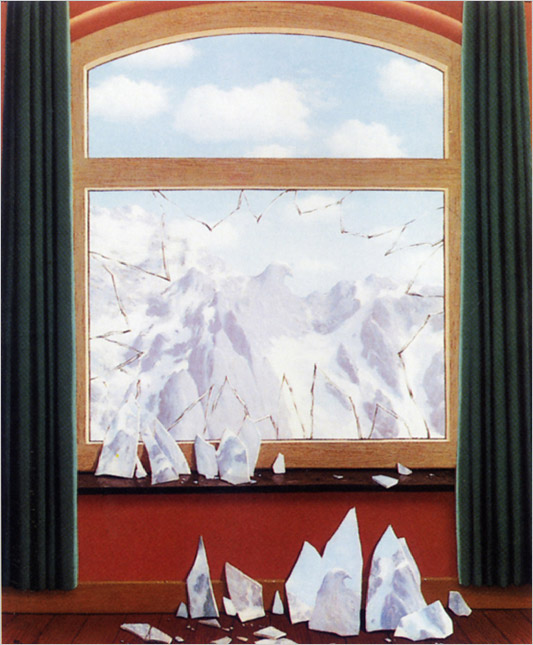
The Domain of Arnheim 1949
Magritte also used the granite eagle on the mountain ridge in others works; this version is especially similar to teh 1947 "Call of the Peaks," which uses a canvas in a window. This image/title pairing is first seen in 1938, though there are two from that year and it’s not certain which one was the first version. The image of the mountain shaped like an eagle predates the “Domain of Arnheim” images, first appearing in “Le precurseur” (1936). The catalogue raisonné says, “The mountain may well have been based upon the upper two-thirds of a color reproduction of a photograph found among Magritte’s papers, something he certainly handled, as it bears a drawing by him on the version.” Here are the known versions of this painting:
1938 - Le domaine d’Arnheim, gouache on paper 30 x 38 - whereabouts unknown
1938 - Le domaine d’Arnheim, oil on canvas
1944 - Le domaine d’Arnheim, gouache on paper 33 x 46 - Caroline Pigozzi
1947 - Le domaine d’Arnheim, gouache on paper 37.1 x 46.2 - Private collection, U.K.
1948 - Le domaine d’Arnheim, gouache on paper 34 x 36 - Private collection
1949 - Le domaine d’Arnheim, oil on canvas 100 x 81 - Private Collection
1962 - Le domaine d’Arnheim, oil on canvas 146 x 114 - Musées Royaux des Beaux-Arts de Belgique, Brussels
1962 - Le domaine d’Arnheim, gouache on paper 35 x 27 - Private Collection
1962 - Le domaine d’Arnheim, gouache on paper, 25 x 19.2 - Eleanor Cramer Hodes
The series has a the granite eagle, the eggs, the wall; sometimes there's a bird's nest. The broken window containing the image of the window was done again with Evening Falls.
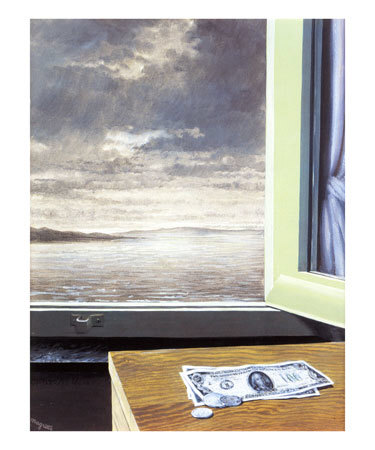
"The Spilt" also known as "The Break" (La Fissure) 1949
Because the money is US currency and Magritte has an art dealer in New York, Alexander Iolas, I could assume the break means a break from the past, it's almost as if we are arriving at the new world (America) on a ship.
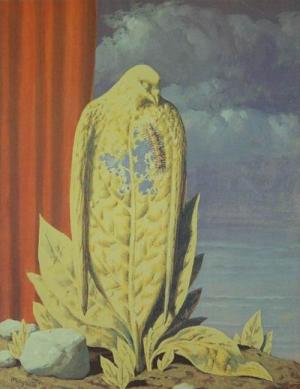
The Flavor of Tears III- 1949
This is the third version of Flavor of Tears Magritte painted. Similar to the Treasure Island paintings it features a war bird. The principle character is being consumed by a catepillar.
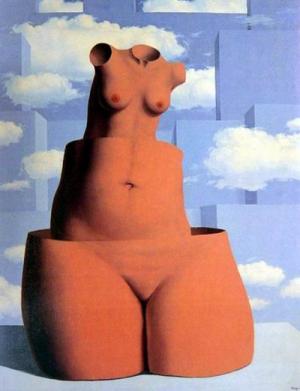
Megalomania- 1949
The Importance of Marvels (L'lmportance des merveilles) was the first painting of this series done back in 1927 when Magritte was in Paris.
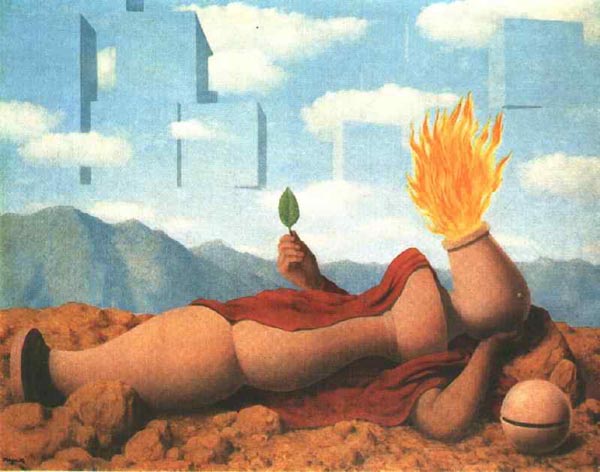
Elementary Cosmogony 1949
Similarly, Magritte’s Elementary Cosmogony (1949) depicts his balustradelike inanimate object, the cicerone, posed like a reclining nude with two human arms.
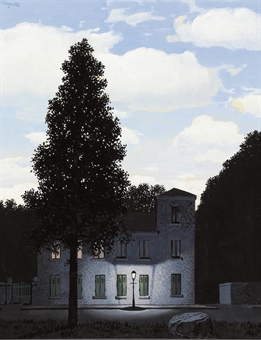
Dominion of Light also known as Empire of Light (L'Empire des lumieres) 1949 signed 'Magritte' (upper left), gouache on paper, 11 5/8 x 9¼ in. (29.5 x 23.5 cm.) First painted in 1949
Magritte had already experimented with a similar theme in his 1948 God's Salon. The painting depicts a night scene with a house brightly lit up by daylight. Clearly this experiment didn't work as well.
"After I had painted 'The Dominion of Light'," Magritte told a friend, "I got the idea that night and day exist together, that they are one. This is reasonable or at least it's in keeping with our knowledge; in the world night always exists the same time as day." Letter to Felix Frabrizio 1966
Magritte also explained the origin of the image in a radio interview in 1956, stating: "What is represented in a picture is what is visible to the eye, it is the thing or the things that had to be thought of. Thus, what is represented in the picture [L'Empire des lumières] are the things I thought of, to be precise, a nocturnal landscape and a skyscape such as can be seen in broad daylight. The landscape suggests night and the skyscape day. This evocation of night and day seems to me to have the power to surprise and delight us. I call this power: poetry" (quoted in D. Sylvester, op cit., p. 145).
According to Roisin (and I agree) the painting L'empire des lumières (the empire of the lights, figure.8) was inspired in Magritte by a poem of Lewis Carroll:
"... the sun on the sea was shining/ it shone with all its forces/ it did its best to reflect the sparkling and calm waves/ and it was very odd, you see, because/ it was in the middle of the night."
Carroll was favorite of the surrealists and Magritte had already named one of his paintings "Alice in Wonderland." Magritte didn't like telling soem of his secrets and especially of giving credit for his inventions to other sources.
The first Empire of Lights completed in 1949, which became Magritte's most popular painting, was sought after by collectors. It was acquired by Nelson Rockefeller in January of 1950 who was a 1939 MoMA director. [In 1939 the 30-year old Nelson Rockefeller became MoMA's President, overseeing the museum's acquisitions policy and expansion into new headquarters.] It ended up in the Alice Lawrence collection and set a new world record for a work on paper by the artist, a whopping $3.55 million. The following notes are from Christie's November 2008 auction:
Provenance: Private collection, Belgium; Galerie Cazeau Béraudière, Paris; Acquired from the above by the late owner, September 2000.
Notes: Between 1949 and 1964, Magritte made seventeen oils and ten gouache versions of L'Empire des lumières, one of his most famous and sought-after themes, each of which displays some variation on a dimly lit nocturnal street scene with an eerily shuttered house and glowing lamppost below a sunlit blue sky with puffy white clouds. Magritte explained the origin of the image in a radio interview in 1956, stating: "What is represented in a picture is what is visible to the eye, it is the thing or the things that had to be thought of. Thus, what is represented in the picture [L'Empire des lumières] are the things I thought of, to be precise, a nocturnal landscape and a skyscape such as can be seen in broad daylight. The landscape suggests night and the skyscape day. This evocation of night and day seems to me to have the power to surprise and delight us. I call this power: poetry" (quoted in D. Sylvester, op cit., p. 145). The first painting from this series (Sylvester, no. 709) depicts a somewhat urban street with a couple of houses and an off-center streetlight. This composition was immediately popular with Magritte's collectors, and was purchased by Nelson Rockefeller in January of 1950. Although Magritte initially preserved this format (fig. 1), by 1951, he had switched this scene to a more rural setting (Sylvester, no 768), depicting a manor house lit from within and introducing the enormous conical tree that also dwarfs the large house in the present work.
The major gouache seen here is similar to versions in oil that Magritte executed in 1954 (fig. 2; Sylvester, nos. 804, 809-810), when collectors were clamoring for further interpretations of this image. The painter increased the size of these works, and selected a vertical format, thus focusing attention on a single dollhouse-like residence whose tightly shuttered first floor is illuminated by lamplight. The glowing second floor windows are obscured by the lowest branches of the tall tree that stretches into the daytime sky. The markedly increased psychological tension of these works from the mid 1950s illustrates Siegfried Gohr's conviction that, by repeating and reinterpreting successful themes, Magritte was "arranging and rearranging visual elements until they produced a shock like a blow from a boxer's glove--whose force, however, remained purely visual and mental" (in Magritte, exh. cat., San Francisco Museum of Modern Art, 2000, p.17). Indeed, this version of L'Empire des lumières best instantiates the uncomfortable if not threatening idea of domesticity that can be found in works by his contemporary Louise Bourgeois (fig. 3). Magritte's mysterious house was also fundamental to the development of early works by Vija Clemins such as House #1 (fig. 4), a house-shaped box that opens to reveal fiery orange tufts of fur.
Magritte's friend, the Belgian poet and philosopher Paul Noug (1895-1967) suggested the title for this image, playing on the double meaning of l'empire ('dominion') as 'territory' and 'dominance.' Noug was undoubtedly sensitive to Magritte's conviction that his paintings never expressed a singular idea, but rather were a form of stimulus that created new thoughts in the mind of the viewer. "Titles play an important part in Magritte's paintings," stated the poet, "but it is not the part one might be tempted to imagine. The title isn't a program to be carried out. It comes after the picture. It's as if it were its confirmation, and it often constitutes an exemplary manifestation of the efficacy of the image. This is why it doesn't matter whether the title occurs to the painter himself afterwards, or is found by someone else who has an understanding of his painting. I am quite well placed to know that it is almost never Magritte who invents the titles of his pictures. His paintings could do without titles, and that is why it has sometimes been said that on the whole the title is no more than a conversational gambit" (quoted in Sarah Whitfield, Magritte, exh. cat. The South Bank Centre, London, 1992, p. 39). Indeed, when Paul Colinet, one of Magritte's closest friends, ventured a definitive explanation for the imagery of L'Empire des lumières, Magritte confided to another friend, "The attempt at an explanation (which is no more than an attempt) is unfortunate: I am supposed to be a great mystic, someone who brings comfort (because of the luminous sky) for unpleasant things (the dark houses and trees in the landscape). It was well intentioned, no doubt, but it leaves us on the level of pathetic humanity" (quoted in H. Torczyner, Magritte, Ideas and Images, New York, 1977, n.p.).
By including day and night, two normally irreconcilable conditions, within a spatially continuous scene, Magritte disrupts the viewer's sense of time. "After I had painted L'empire des lumières," he recalled to a friend in 1966, "I got the idea that night and day exist together, that they are one. This is reasonable, or at the very least it's in keeping with our knowledge: in the world night always exists at the same time as day. (Just as sadness always exists in some people at the same time as happiness in others.) But such ideas are not poetic. What is poetic is the visible image of the picture" (quoted in ibid.). André Breton also recognized in this work the unconventional reconciliation of opposites that the Surrealists prized, stating: "To [Magritte], inevitably, fell the task of separating the 'subtle' from the 'dense,' without which effort no transmutation is possible. To attack this problem called for all his audacity--to extract simultaneously what is light from the shadow and what is shadow from the light (l'empire des lumières). In this work the violence done to accepted ideas and conventions is such (I have this from Magritte) that most of those who go by quickly think they saw the stars in the daytime sky. In Magritte's entire performance there is present to a high degree what Apollinaire called "genuine good sense, which is, of course, that of the great poets" (A. Breton, "The Breadth of Rene Magritte" in Magritte, exh. cat., Arkansas Art Center, Little Rock, 1964, n.p.).
(fig. 1) René Magritte, L'Empire des lumières, 1950, Museum of Modern Art, New York. BARCODE 25995213
(fig. 2) René Magritte, L'Empire des lumières, 1954, Peggy Guggenheim Collection, Venice, The Solomon R. Guggenheim Foundation, New York. BACODE 20625528
(fig. 3) Louise Bourgeois, Femme-maison, 1946-47, private collection. BARCODE 25995190
(fig. 4) Vija Clemins, House #1, 1965, Museum of Modern Art, New York. BARCODE 25995206
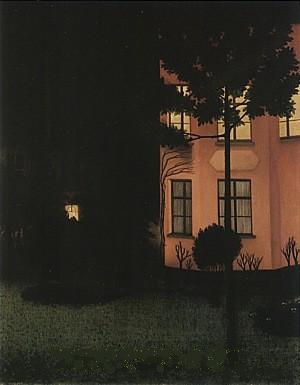
The Pink House- 1892 by William Degouve de Nuncques (Belgian symbolist painter 1867-1935)
This painting is surely the inspiration of Magritte's various Empire of Light paintings. At first glace Degouve de Nuncques' painting looks to be quite normal but if you look at the house the exterior is magically lit up as if in daylight. Degouve de Nuncques, William (Belgian, 1867-1935)—Born in the Ardennes region, son of an aristocratic family. He was a friend of Henri De Groux, and posed for Christ in one of his pictures. In 1883, he shared a studio with the Dutch Symbolist Jan Toorop. Degouve de Nuncques had particularly strong literary connections. He married a sister-in-law of Émile Verhaeren and designed the decor for at least one of Maeterlinck's plays. His painting, The House of Mystery, or The Pink House (1892), was inspired by Edgar Allan Poe's Gothic tale "The Fall of the House of Usher."
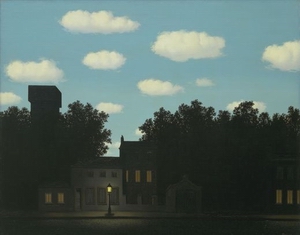
The Empire of Light II, 1950
One of the many versions which is less effective because of the distance of the viewer to the light from the lamppost.
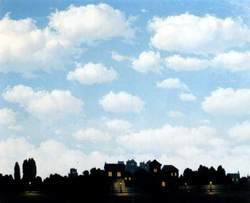
The Dominion of Light III- 1953
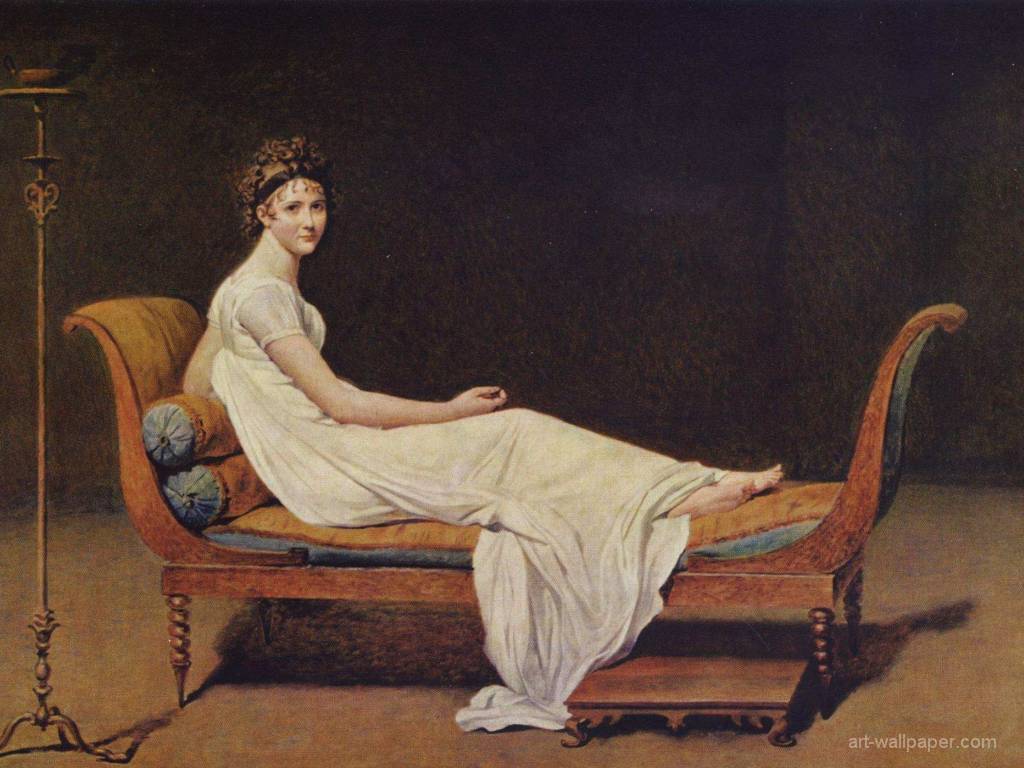
David's Madame Recamier
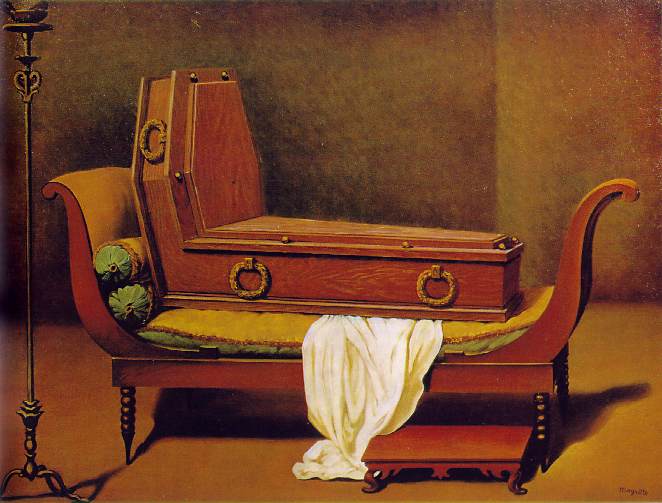
Perspective I: Madame Recamier de David, 1950, 23.6 x 31.5 in. / 60 x 80 cm
Perspective I: Madame Récamier by David (1951, 60x80cm) is the first "coffin" painting. During the late 1940s and early 1950s Magritte made a series of "Perspective" paintings based on well-known works by the French artists François Gérard, Jacques Louis David, and Édouard Manet, in which he substituted coffins for the figures represented in the original paintings. The composition of this work is almost identical to that of David's famous portrait of Madame Récamier, except that the seductive young sitter has been replaced by a coffin, with a cascading gown left as the only trace of her previous existence. Executed in Magritte's carefully detailed style, this irreverent rendition of the Neoclassical masterpiece is suffused with mordant wit.
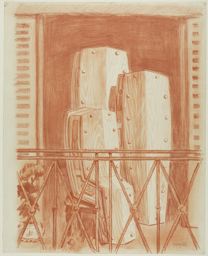
Perspective II: Manet's Balcony; red chalk drawing (earliest version circa 1948-1949)
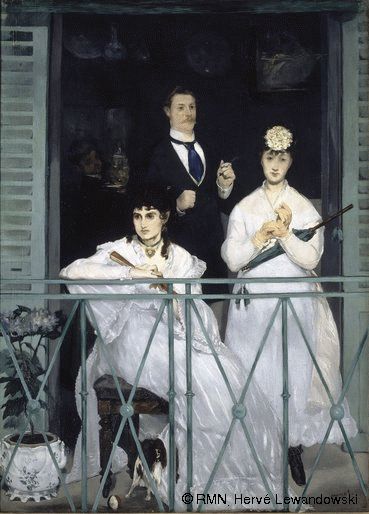
Edouard Manet (1832-1883) The Balcony 1868-1869 Oil on canvas H. 170; W. 124.5 cm
.jpg)
René Magritte's Perspective II: Manet's Balcony. 1950. Oil on canvas. 81 x 60 cm
%201950.jpg)
The Handsome Brooder (Le beau ténébreux) 1950
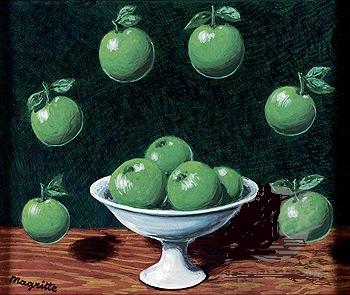
The Principle of Archimedes (Le Principle D'Archimedes) No Date Given
It is most famously attributed to the ancient Greek scholar Archimedes; he reportedly proclaimed, "Eureka!" when he stepped into a bath and noticed that the water level rose – he suddenly understood that the volume of water displaced must be equal to the volume of the part of his body he had submerged. This meant that the volume of irregular objects could be calculated with precision, a previously intractable problem. He is said to have been so eager to share his realisation that he leapt out of his bathtub and ran through the streets of Syracuse naked. Magritte used the "Eureka" of Archimedes to describe another painting "Time Transfixed" when the association of two incongruent (train and Fireplace) objects became as one. Is Magritte saying the apples displaced (in the air) equal the apples in the vase? I doubt it, he used titles to add mystery.
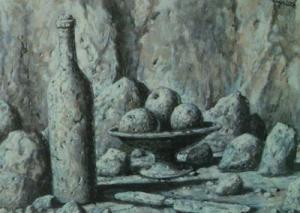
Memory of a Journey (Souvenir de Voyage) 1950 oil, 35 x 46 cm
Memory of a Journey (Souvenir de Voyage) is a series of paintings Magritte started in 1950 that used pertification; turning everything into stone. This first painting is truly a still life!
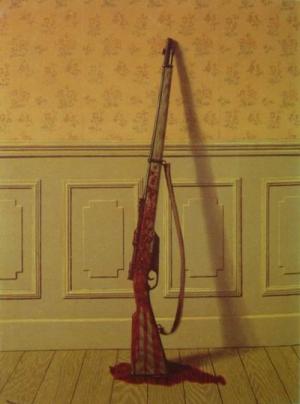
The Survivor (Le Survivant) 1950
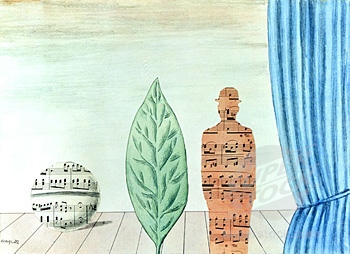
Musical moments (Moments Musicaux) Collage 1950
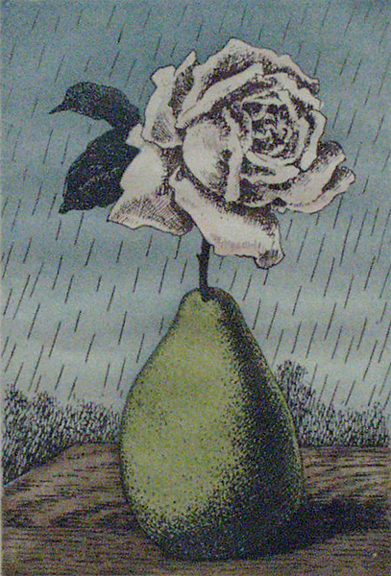
Rose and Pear 1950
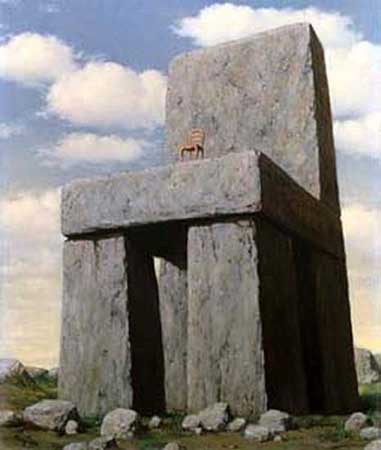
The Legend of the Centuries II (La Legende des Siécles II) 1950
Magritte made several versions of this, the first dates back to 1948. It's uses pertrification as well as magnification. This was the precursor for the successful Art of Conversation series.
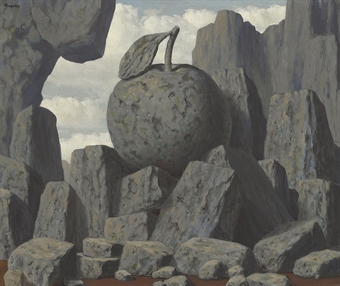
The Pledge (La parole donnée) 1950 signed 'Magritte' (upper left); dated and titled '1950 "La PAROLE DONNÉE"' (on the reverse)
oil on canvas 16 7/8 x 23¾ in. (42.8 x 60.3 cm.) Painted in 1950 THE COLLECTION OF ALICE LAWRENCE Also sometimes titled "The Word Given"
Provenance: Acoris Gallery, London (by 1974); Galleria Gissi, Turin; Carl Laszlo, Basel; Private collection, Switzerland (acquired from the above); sale, Christie's, London, 29 November 1989, lot 566. Acquired at the above sale by the late owner.
Literature: D. Sylvester, ed., René Magritte, Catalogue Raisonné: Oil Paintings, Objects and Bronzes 1949-1967, London, 1993, p. 173, no. 748 (illustrated).
Exhibited: Brussels, Galeries Dietrich and Lou Cosyn, Exposition Magritte, April 1951, no. 11.
(Possibly) Mons, Museée des Beaux-Arts, Art Contemporain, 1952, no. 50.
(Possibly) Verviers, Cave des Temps Mêlés, Exposition: Magritte, March 1953, no. 11.
(Possibly) Liège, Galerie du Carré, René Magritte, September-October 1953, no. 8.
Brussels, La Sirène, Oeuvres récentes de René Magritte, October 1953, no. 18.
La Louvière, Maison des Loisirs, René Magritte exposé, March-April 1954.
Brussels, Palais des Beaux-Arts, René Magritte, May-June 1954, no. 84.
(Possibly) Antwerp, Stedelijke Feestzaal-Meir Antwerpen, Kunst van heden: salon 1956, October 1956, no. 113.
London, Acoris Gallery, Surrealist Masters, 1974, p. 82. no. 39 (illustrated in color).
Notes: La parole donnée is part of a series of twenty paintings depicting organic objects turned to stone that Magritte started in 1950. Sometimes referred to as his "stone age pictures," these works celebrate Magritte's love of paradox; the first of these images (Sylvester, no. 737; Private collection, Brussels), for example, depicts a monumental stone chair whose aura of primeval significance is undercut by the miniscule wooden chair that is perched delicately upon its enormous seat. This punning yet eerie transformation of mundane objects through alterations in scale and material also occurs with living things such as a large petrified fish that would undoubtedly sink if plunged into water (fig. 1; Sylvester, no. 1022) and the giant stone apple seen here, whose leafy stem underscores both its arrested growth and its incongruous presence amongst forebodingly angular outcroppings of mottled grey stone. Indeed, Magritte regarded the state of petrification as a visual expression of disaster and death. As Abraham Hammacher has stated, "One can trace this preoccupation with a petrified world in all. Magritte's works Magritte did not regard petrification as a process, but as a kind of catastrophe, like that at Pompeii, when lava transfixed the world and brought all movement to a halt" (in Magritte, London, 1974, p.140). The theme of objects transformed or transforming into stone also reprises the inherent violence of Magritte's earlier series of paintings in which figures in famous works such as Manet's Le Balcon or David's Portrait de Mme Récamier are replaced by coffins (fig. 2; Sylvester, nos. 710 and 742), or the metamorphic paintings of 1927 in which landscapes, and figures are changed into wood (Sylvester, nos. 184- 187).
The present painting is the second of four images of solitary fossilized apples that share the title La parole donnée, which translates as "the pledge." The first of these (Sylvester, no. 747) is a preliminary version of the present scene that was also painted in the second half of 1950, yet it lacks the more elaborate setting seen here, with its looming cliffs, open sky, and rocky foreground. The other two both stem from is set within a bleak landscape and has a blue yet cloud-filled sky visible in the background. The following two both stem from the early to mid 1960s, and display more massively-scaled apples similar to his concomitant series of petrified apples entitled Souvenir de voyage (Sylvester, nos. 735, 736, and 964) and La grande table (Sylvester, no. 964). In the painting from 1963 (Sylvester, no. 971), the apple has reached epic proportions, dominating the canvas and dwarfing the seemingly miniscule mountain range behind it. Although the uneven topography of the canvases from 1950 has been transformed in this variation into a flat valley with a bisecting river, the jutting boulders reappear in the last adaptation of this theme (Sylvester, no. 1009), where the petrified apple appears on a nest-like accumulation of jagged stones on the shore of a mirror-smooth lake. A setting red sun hangs low in the sky over this barren moonscape. As David Sylvester notes, the preternatural calm displayed by these four images possesses an eerie quality, and he has commented that "La parole donnée has the violence of an earthquake at the start of time" (in Magritte, exh. cat., Tate Gallery, London, 1969, p.12).
The apple is one of the most frequent and recognizable of Magritte's motifs, appearing in various guises such as a floating orb in the sky, a masked entity, and perhaps most famously hiding the face of a man wearing a bowler hat (fig. 3). The ambiguity of its role in the present scene invites the viewer to contemplate possible interpretations without ever offering a definitive meaning, sustaining a sense of enigma that the painter prized above all else. For Magritte, the apple came to symbolize this perpetual tension between the hidden and visible, and he even used it to obscure his own visage in some of his self-portraits. The painter stated: "Those of my pictures that show very familiar objects, an apple, for example, pose questions. We no longer understand when we look at an apple; its mysterious quality has thus been evoked. In a recent painting, I have shown an apple in front of a person's face At least it partially hides the face. Well then, here we have the apparent visible, the apple, hiding the hidden visible, the person's face. This process occurs endlessly. Each thing we see hides another, we always want to see what is being hidden by what we see. There is an interest in what is hidden and what the visible does not show us. This interest can take the form of a fairly intense feeling, a kind of contest, I could say, between the hidden visible and apparent visible" (quoted in H. Torczyner, op. cit., 1997, p.170). Suzi Gablik suggests that "Magritte's paintings are a systematic attempt to disrupt any dogmatic view of the physical world. By means of the interference of conceptual paradox, he causes ordinary phenomena to inherit extraordinary and improbably conclusions. What happens in Magritte's paintings is, roughly speaking, the opposite of what the trained mind is accustomed to expect. His pictures disturb the elaborate compromise that exists between the mind and life. In Magritte's paintings, the world's haphazard state of consciousness is transformed into a single will" (in Magritte, New York, 1985, pp.112 and 114).
Magritte's transformation of a humble apple into an impressive boulder also reflects the enduring impact of the Italian painter Giorgio de Chirico's pittura metafisica on his oeuvre. De Chirico's images such as Le Chant d'amour, 1914 (fig. 4), which was a seminal discovery for Magritte during the early years of his career, portrays inconsequential objects such as a ball or a glove as monumental symbols with mysterious and ultimately indeterminate import. Similarly, Magritte confers the qualities associated with rocks, such as heaviness and immobility, to the apple, creating a seemingly permanent monument to what is ordinarily a highly perishable foodstuff.
(fig. 1) René Magritte, Connivance, 1965, Private collection. BARCODE 25995183
(fig. 2) René Magritte, Perspective: Madame Récamier de David, 1950. BARCODE 25995169
Private collection.
(fig. 3) René Magritte, La Grande Guerre, 1964, Private collection. BARCODE 25595176
(fig. 4) Giorgio de Chirico, Le Chant d'amour, 1914, The Museum of Modern Art, New York.
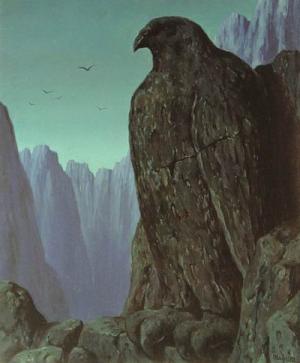
The Wasted Footsteps- 1950
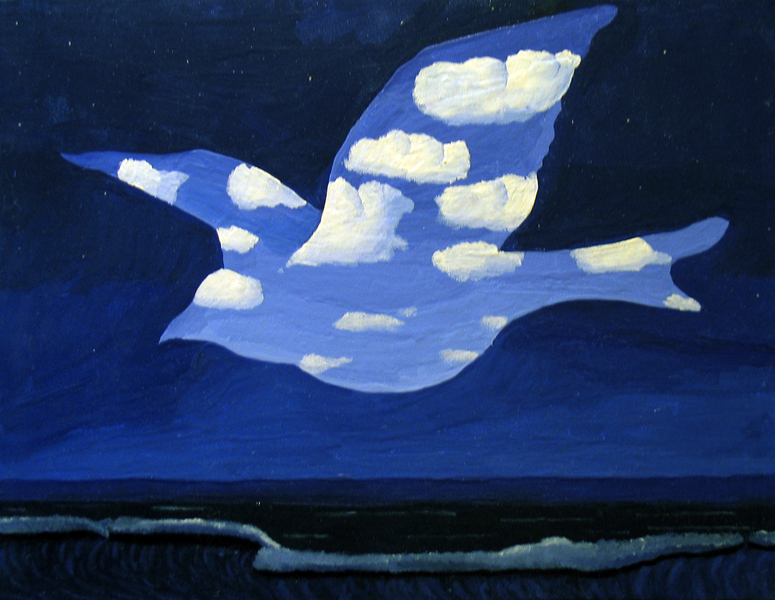
The Promise (La Promisse) 1950
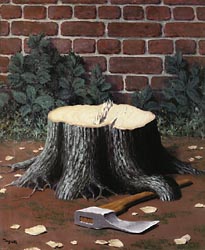
The Labors of Alexander 1950
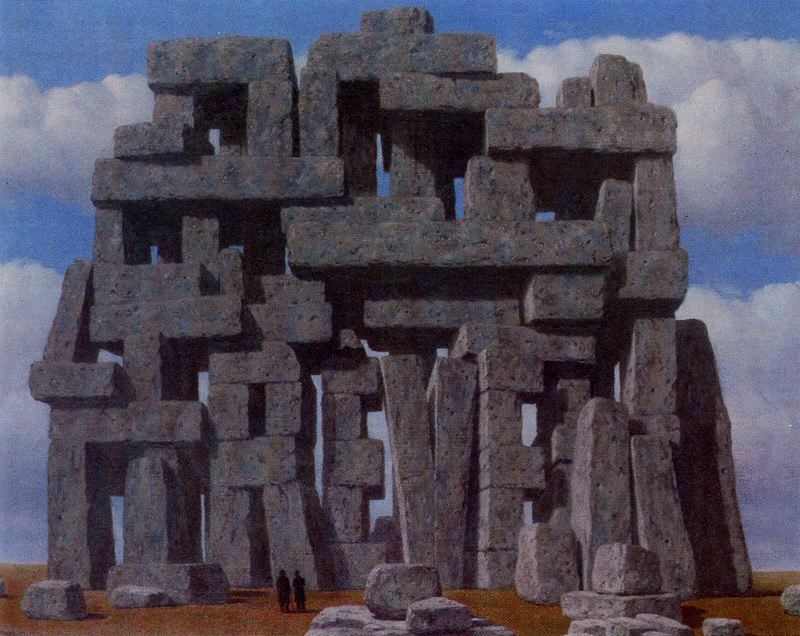
The Art of Conversation I (L'Art de la conversation I) 19.7 x 23.6 in. / 50 x 65 cm
This series that started in 1950 features a pile of rock forming the word "Reve" (dream). To me this seem like Magritte's tribute to Stonehenge.
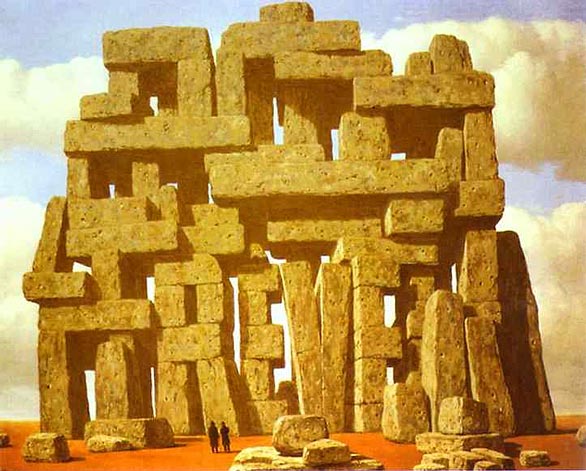
The Art of Conversation- Color Variation (L’Art de la Conversation)

Art of Conversation II (L'Art de la conversation II) 1950, 19.7 x 25.6 in. / 50 x 65 cm
Again the giant stone formations spells the word "Reve" or Dream.
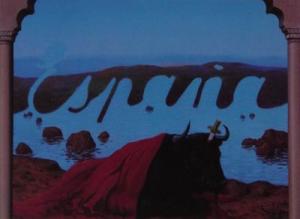
Art of Conversation III aka L'Art de la conversation III, 1950, 19.7 x 25.6 in. / 50 x 65 cm
This image is rather dark but it shows a bull that has died at the hands of a torero in the foreground. The cut-out in the back section of the water spells "Espana" or Spain.
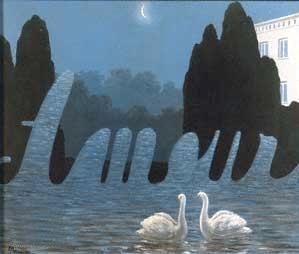
Art of Conversation- Variation IV 1950
This is Magritte's transpostion of a Bocklin island, in this case, The Island of The Living. In the back section of the water, the cut-off spells "Amour" or Love.
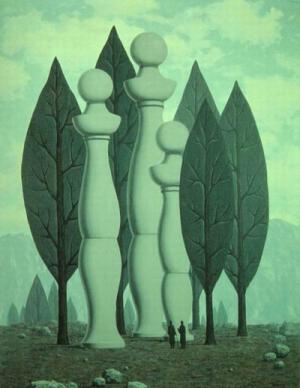
Art of Conversation V (L'Art de la conversation V) 1950, 19.7 x 25.6 in. / 50 x 65 cm
Here Magritte uses two of his icons (the Giantess and the Bilboquet) having a little meeting- elevated conversations to be sure!
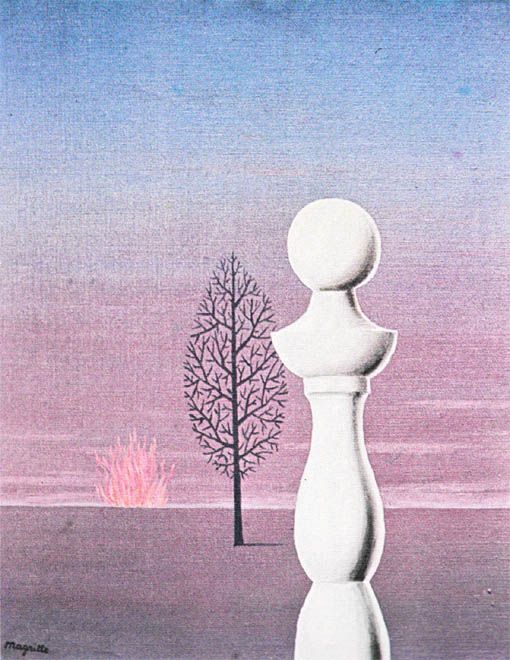
Fashionable People- 1950
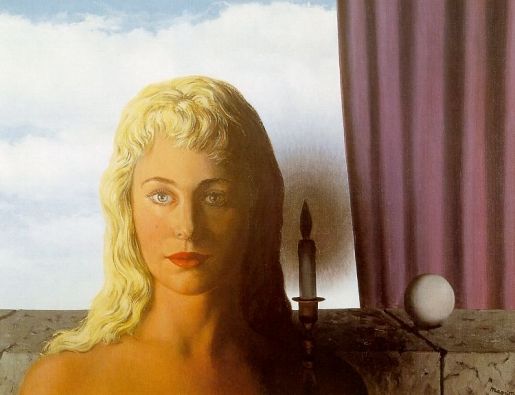
The Ignorant Fairy 1950
The model for this painting is Marie-Anne Crowet. The same portrait is used later in Magritte's mural. Marie-Anne Crowet's father was Pierre Crowet who met Magritte in 1926 when Pierre was a student in Brussels. According to Pierre, "I ran into Rene Magritte from time to time (both of us being from Charleroi, we hit it off quite well). I admired his work and wanted to purchase one of his paintings but did not have any money. To help me out, he sold The Forest to me fro 500 Belgian francs payable in installments of 50 francs per month. This was my first purchase and the start of my collection." Pierre was a lifelong friend and commissioned of his wife and daughter who was the inspiration for The Ignorant Fairy which later in 1956 became the central theme for Magritte's large mural commissioned by the Musee de Charleroi with the same title.
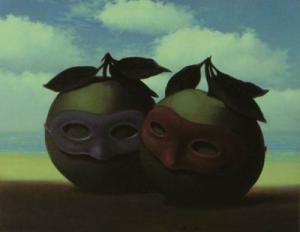
The Hesitation Waltz- 1950
The apple with a mask became a series of paintings later titled, "The Married Priest." Eroticism, understood both in light of the Marquis de Sade and Sigmund Freud, was fundamentally important to the Surrealists. In my opinion the apples are wearing a mask as if displaying a Marquis de Sade type costume. The image of the masked apple first appeared in 1946 fro a cover design Magritte did of "The View."
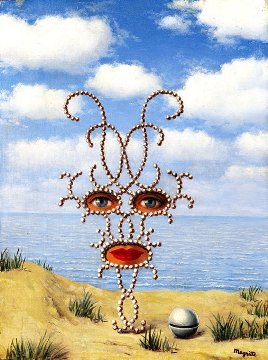
Sheherazade 1950
One of first of many Sheherazade themes Magritte painted. Magritte probably based his ideas on Edgar Allan Poe's "The Thousand-and-Second Tale of Scheherazade." From Poe, "Her name was Scheherazade, and her idea was, that she would either redeem the land from the depopulating tax upon its beauty, or perish, after the approved fashion of all heroines, in the attempt."
Poe's tale is based on the legendary Persian queen, Scheherazade, the storyteller of One Thousand and One Nights. The original tale goes: Every day Shahryar (or "king") would marry a new virgin, and every day he would send yesterday's wife to be beheaded. This was done in anger, having found out that his first wife was betraying him. He had killed three thousand such women by the time he was introduced to Scheherazade, the vizier's daughter.
In Sir Richard F. Burton's translation of The Nights, Sheherazade was described in this way:
"Sheherazade had perused the books, annals and legends of preceding Kings, and the stories, examples and instances of by gone men and things; indeed it was said that she had collected a thousand books of histories relating to antique races and departed rulers. She had perused the works of the poets and knew them by heart; she had studied philosophy and the sciences, arts and accomplishments; and she was pleasant and polite, wise and witty, well read and well bred."
Against her father's protestations, Scheherazade volunteered to spend one night with the King. Once in the King's chambers, Scheherazade asked if she might bid one last farewell to her beloved sister, Dinazade, who had secretly been prepared to ask Scheherazade to tell a story during the long night. The King lay awake and listened with awe to Scheherazade's first story and asked for another, but Scheherazade said there was not time as dawn was breaking, and regretfully so, as the next story was even more exciting.
And so the King kept Scheherazade alive as he eagerly anticipated each new story, until, one thousand and one adventurous nights, and three sons later, the King had not only been entertained but wisely educated in morality and kindness by Scheherazade who became his Queen.
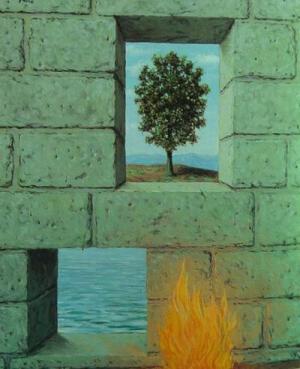
Mental Complacency (Le Confort de l'esprit) 1950, 18.1 x 14.7 in. / 46 x 38 cm
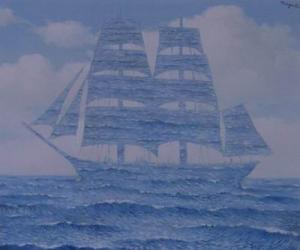
The Seducer I (Le Seducteur I- 1950) 19 x 23 in. / 48.2 X 58.4 cm
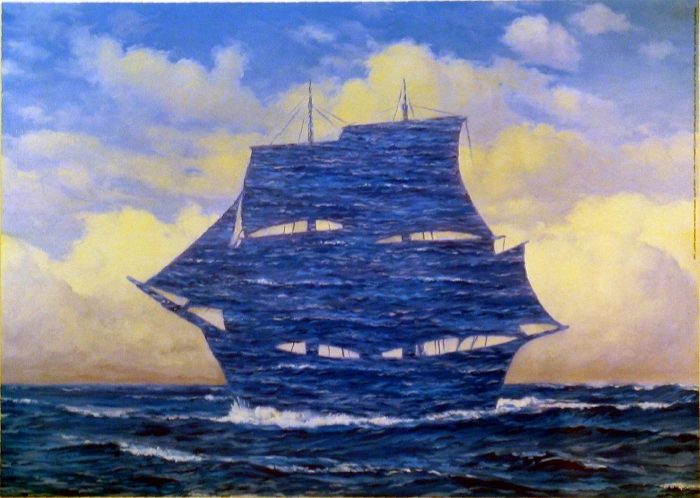
The Seducer Lithograph
[Review by John Haber] Certainly no one would mistake The Seducer, painted in 1950, for an ordinary landscape. A ship floats alone on an ideal sea, surrounded by one of Magritte's favorite motifs, clouds. Think of the idiom in English today, cloud nine. One has no indication of time, place, or the weather, no hint of sunlight or rain beyond the blue sky and stereotypical cumulus clouds. The sailing ship—of a kind once built for long ocean voyages—belongs to some unspecified past as remote and idealized as a manipulated dream world.
Magritte probably had little personal experience of the sea anyway. He grew up almost dead center in Belgium, in a small town southwest of Brussels, where the plains of Waterloo start to give way to the hilly terrain of Mons. He returned from Paris to Brussels in 1930, pretty much for good. One could call him the perfect bourgeois, a role he loved to play in his art, although indications of an actual city appear as rarely in his art as anything else concrete.
Even back in the time of sailing ships, Belgium never rivaled its neighbors as a naval power. The Dutch, after breaking free of Spain, celebrated their ports in Baroque art, but not the Flemish. If Magritte ever felt the call of the sea, it had to mean a call within.
Most obviously unlike a seascape, Magritte has done something odd indeed to the ship: he has replaced its shape with an extension of the water. Surrealism celebrated just such illogical, uncanny juxtapositions. Breton liked to cite a writer calling himself Comte de Lautréamont, who in 1868 asked for an image "as beautiful as the chance meeting on a dissecting table of a sewing machine and an umbrella." One can think of the ship's transformation as a cut-and-paste job, and Surrealism has its roots, like pretty much all modern art, in Cubist collage.
If that leaves only a dream, the painting's title, The Seducer, also suggests uncensored fantasy, and Magritte himself spoke of painting not just real objects, as in a still life, but "real desires." Whoever is carrying out a seduction, no one is restraining his transgression. In French, seduction has connotations of pleasure and magic, and some critics have termed his art "magic realism"—and a precursor of the movement in America that spawned Philip Evergood and George Tooker. However, the seducer does not clearly appear. The pleasure seeker could be riding on the ship, painting it, or looking at it in the museum now. So could the one seduced—perhaps Magritte himself seduced by his own art.
In English, and Magritte did know English, seduction implies deception or trickery. One is seduced by the promises of a lover, a salesman, a politician, or an artist. If the painting first, then, simply piles on symbols of floating and pleasure, it also seems clearly designed to trick one into taking nonsense for reality. Just what is the sea doing up there with the ship, and what does this have to do with a human lover?
Maybe nothing. The Surrealists knew that dreams resist interpretation, which is why they liked them. However, Magritte pushes their illogic further, to the point that it questions naturalism and illusion in art. It may even question fixed meanings entirely. He juxtaposes two kinds of signs, the visual emblem and word seducer, and he detaches both from what they would ordinarily signify. If other Surrealists approach dreams as psychologists, Magritte gives the movement its linguistics department.
In maybe his most famous work, the words This Is Not a Pipe hover over the image of a pipe. By unmooring language and representation from their usual function, he could be daring one to accept art and the mind as the scene of endless free associations, of perpetual free play. More frighteningly, he could be presenting the breakdown of meaning itself. One can take the marks of waves over the sails as an erasure, an insistence that this is not a ship. Either way, one cannot approach his art in the same way as older painting. One cannot pore over its perceptual cues in order to reconstruct the natural world or its symbolism to decipher a divine one.
Both alternatives—free play and a loss of meaning—remain pertinent. One can see The Seducer as carefully analyzing and displacing illusion. One can consider the water covering the ship as a reminder that, in a proper representation, an approaching ship would once have lain below the horizon. Besides, unmooring has its own connotations when it comes to the sea. Do these first two layers of meaning, pleasure and critical reflection on painting itself, contradict each other? Absolutely, and that already suggests a third, more unsettling level of interpretation, one that many Surrealists themselves sometimes overlooked in his art.
The Surrealists never recognized Magritte as fully one of their own. For one thing, they distrusted trickery, even or perhaps especially under the guise of toying with convention. For such a cosmopolitan circle, they talked about psychic automatism and a kind of primitive impulse underlying art. They did not like formalism, systematic investigations of language, or Magritte's seemingly conventional illusion. Conversely, they liked the literal, continuous three-dimensional space of Dalí's landscapes. How ironic (and delightful) that Magritte has lent himself to reinterpretation as photography, by Naomi White.
For another, they moved easily from desire to violence and from dreams to nightmares. Think of Giorgio de Chirico's dark, empty streets, Dalí's swarms of ants, or his infamous watch melting over what may pass for a dead horse. Think of Max Ernst's Two Children Menaced by a Nightingale, with its open razor and the children fleeing in terror. Think of Alberto Giacometti's haunted Palace at 4 A.M., a confinement that Philip Guston must have admired.
The Belgian may have seemed rather tame by comparison. In The Menaced Assassin, a woman lies naked with her throat cut, but the assassin still has time to listen to the gramophone. His likely abductors in turn wear middle-class suits and bowler hats. They satirize middle-class conventions savagely enough, and they suggest something fearful beneath, but they recognize them as part of life. When Magritte brings out the machinery of war, his cannon points hopefully On the Threshold of Liberty. For most Surrealists, taking liberties meant taking serious risks.
The ship and water have the same ambiguity. Water could have floated above the sea, lifting the boat with it and changing a warship into a pleasure craft. Then again, the water could have swamped the boat and the faint outlines of people on it. Like the "chap" in Stevie Smith's poem, they could be "much further out than you thought, / And not waving but drowning." The call of sea includes the great sailing ships and the discovery of the New World, but also the lure of sirens. And you know what happened to those who listened.
Probably no other painting of his comes as close to monochrome, further obliterating the border between sea and sky. The wave crests may resemble the traces of a ship firmly scudding across the high seas, or they may look like treacherously choppy water during a storm. A variant dated three years later, now in a private collection, may incline more closely toward the first, the version in the Virginia Museum of Fine Arts toward the second. With its typically shameful lack of mission, the Guggenheim passed up a Magritte retrospective that stopped at SF MOMA in 2000, so New Yorkers may never really know which of his manifold disguises represents him best.
Just as when he first shreds to pieces illusion and language, Magritte makes it impossible to separate comedy, poetry, illusion, and darkness. He can seem as literal as ordinary language, the kind that already uses "going to sea" as a metonym for sailing—and as paradoxical. He can make the rest of Surrealism, with its illustrated Existential crises, ponderous and philosophically naïve by comparison.
The puzzling seducer may appear in name only because pleasure, much less love, is out of the question. In more than one early painting, lovers try to kiss, but with their heads covered in shrouds as if for a funeral. The most notorious seducer of all goes to hell at the end of the opera, but maybe, just maybe, Magritte's watery ship will continue on its course.
René Magritte's "The Seducer" (1950) is in the collection of the Virginia Museum of Fine Arts, a gift of Paul Mellon.
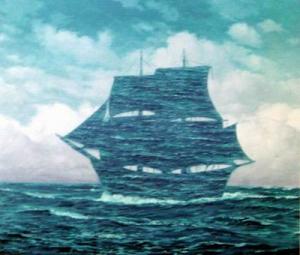
The Seducer II (Le Se'ducteur II- 1951) 19.5 x 23.6 in. / 50 x 60 cm
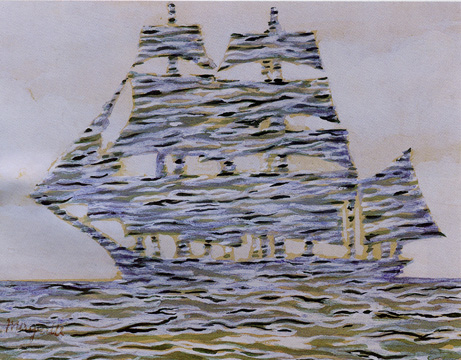
The Seducer "Le Seducteur" gouche on paper, 5 1/8 by 7 1/8 inches, 1951
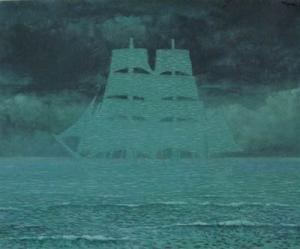
The Seducer III (Le Se'ducteur 1953) 15 x 18.1 in. / 38 x 46 cm
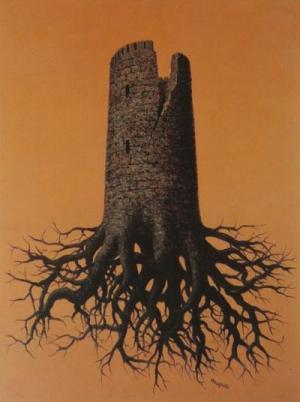
Almayer's Folly (La Folie Almayer) 1951
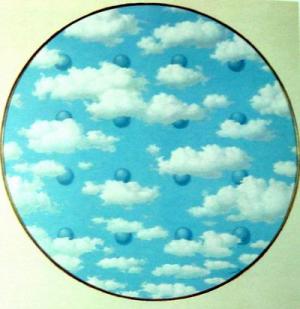
Clouds and Bells (Nuages et grelots) 1951
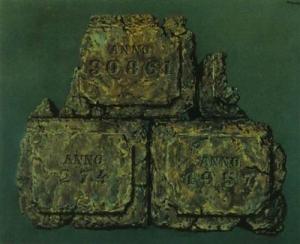
The smile II- Le Sourire, 1951
The second version of The Smile, which are grave headstones stacked with Anno and a date below, the bottom right is 1957. The first Smile was created during the Renoir sunlit period in 1943.
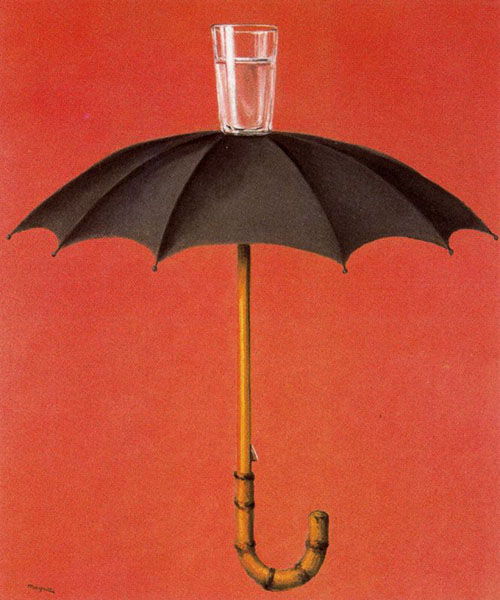
Hegel's Holiday 1951
This is one of the paintings Magritte did referencing the German philosopher Georg Hegel [Hegel's dialectics]. Magritte owned a French translation of Hegel's works and his philosophy of painting was organized in a similar way: By juxtaposing opposite images the mind seeks to resolve the conflict. Here the glass catches water while the umbrella repells water.
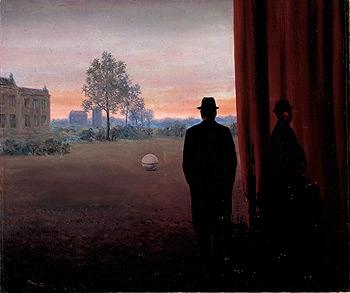
Going towards pleasure (A La Rencontre Du Plaisir) 1950
This is similar in some ways to La Connaissance- the grelot (bell shaped object) is the focal point, sitting mysteriously in an open field. A man with a bowler hat watches entraced- while behind the curtain his shadow stands, facing in a different direction.
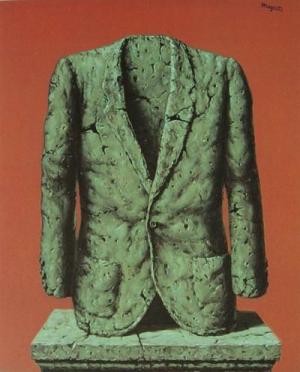
The Magic Potion Le Philtre, 1951
Another of the many paintings using pertrification. The interesting thing about this- at least what Magritte was trying to do- he is presenting a statue, made out of stone of a man wearing a suit. The trick is: the man is missing or invisible.
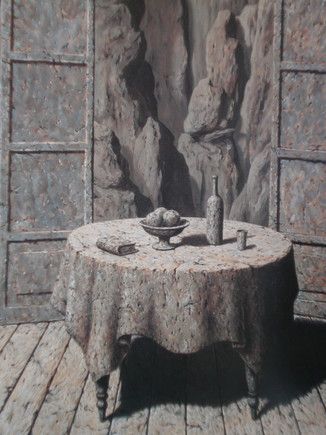
Memory of Journey III ( Souvenir de voyage) 1951
Magritte's Memory of a Journey series began in 1951 and features the scene turned entirely into stone. This petrification is complete and in one version "only the light from the candle is natural" said the artist. "The indifference of stones is the same as not existing," Magritte added. For some reason the first Memory of a Journey is catalogued "Memory of Journey III."
The Song of the Violet (below) and The Magic Potion (above) are other paintings in which everything appears to be made from stone. In Memory of a Journey (1955) Marcel Lecomte, mineral poet, stands next to a stone lion.
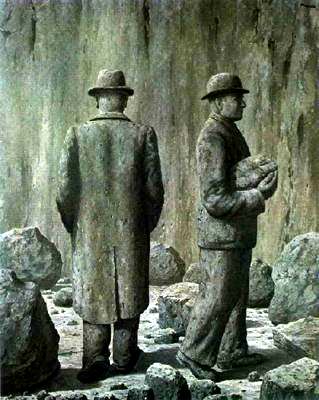
Song of Violet 1951
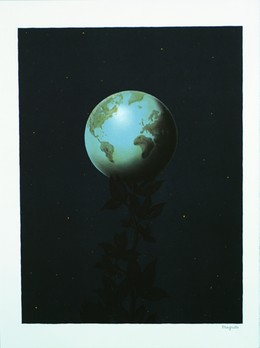
Le Grande Style 1951
This is one of the lithographs done in the 1960s. It's difficult to see: there's a branch with leaves with the world appearing as an orb at the end of the branch, almost as if it's a flower.
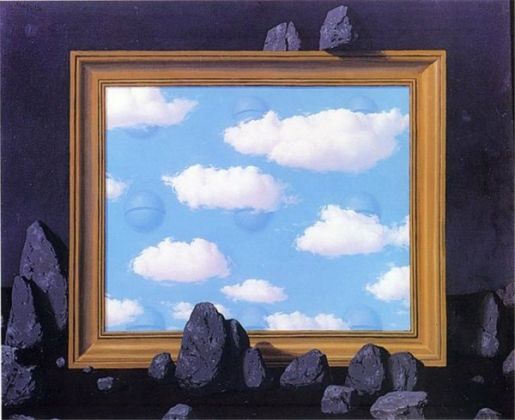
The Great Tide (La Grande Marée) 1951
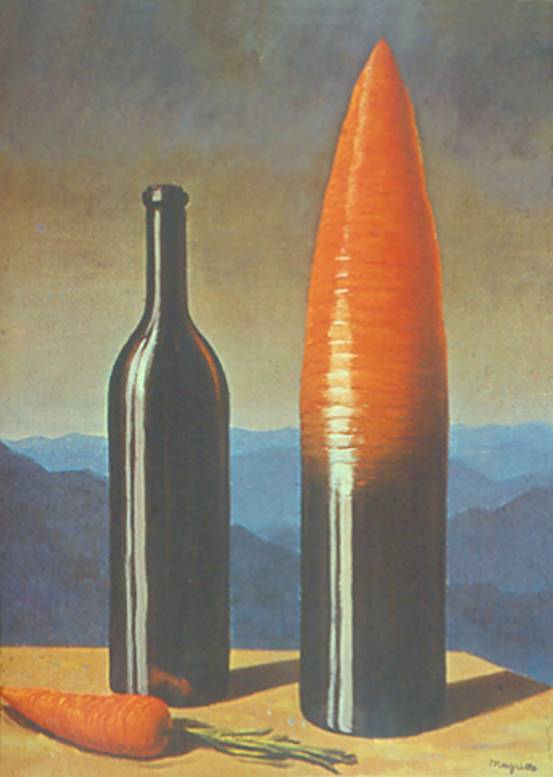
The Explanation (L'Explication) 1952
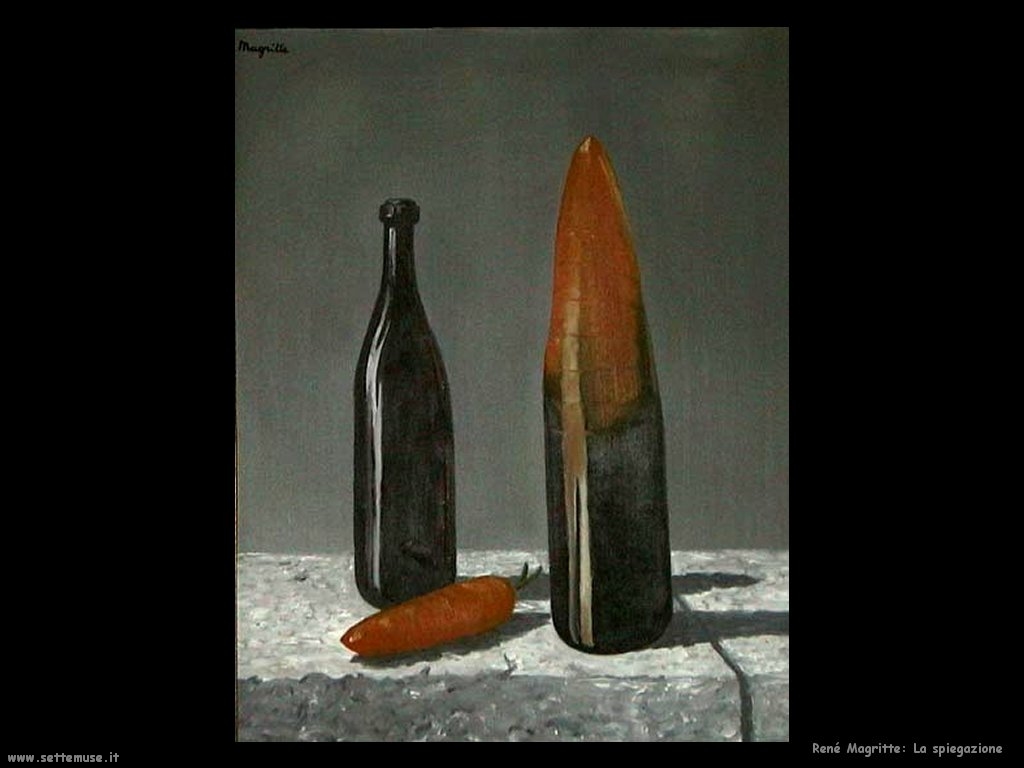
The Explanation II (L'Explication) No date given
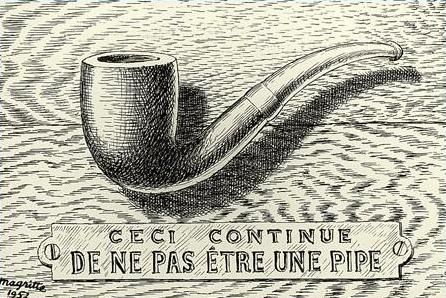
The Treason of Images (variation) 1952
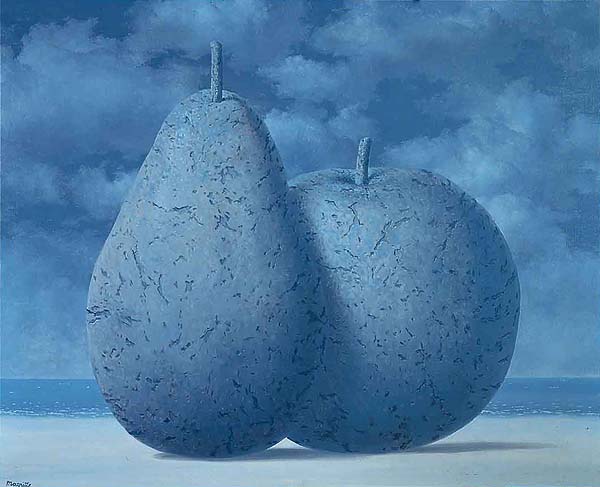
Memory of a Journey II (Souvenir de Voyage) 1952
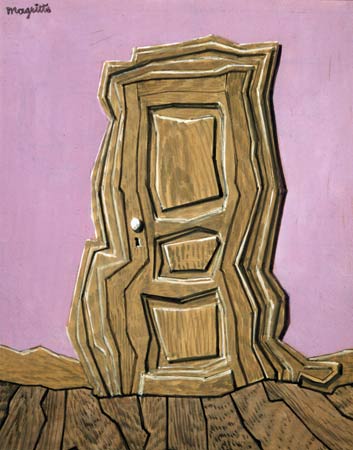
The Vibrant Model (Le Modele Vivant) gouche 1952
In my opinion The Vibrant Model is Magritte's best example of distortion. It's like you are at the amusement park in the House of Mirrors.
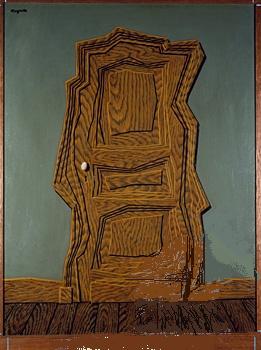
The Vibrant Model (Le Modele Vivant) 1952
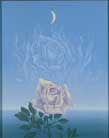
The Beautiful Language (Le beau langage) 1952
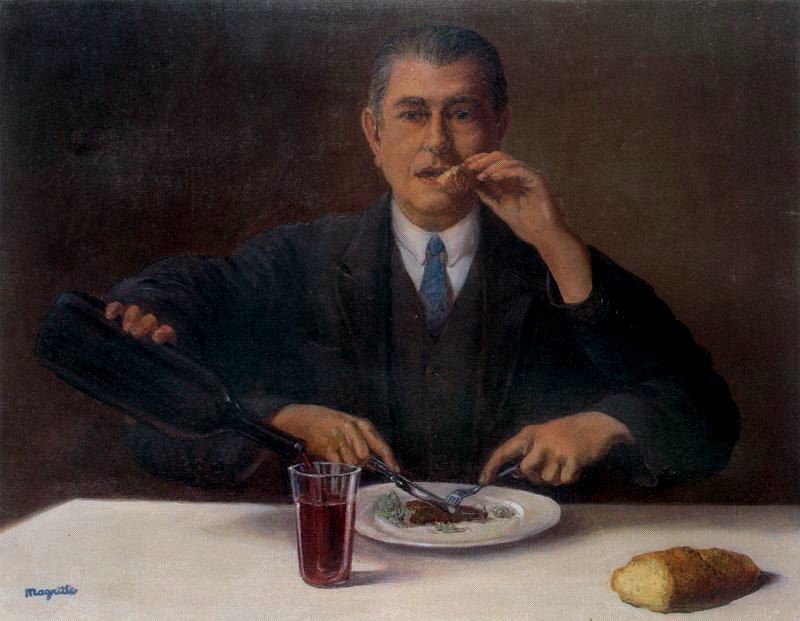
The Magician 1952
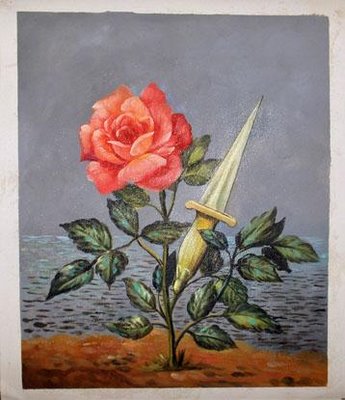
Le Coup au Coeur (The Blow to the Heart) 1952
Le Coup au coeur is a painting of one of Magritte's icons: the rose (for another rose painting see also: Le tombeau des lutteurs- 1960). In his painting below you can see the thorns have been replaced by a sword or dagger. It's as if the beautiful flower has been transformed into a gladiator that has arrived from the sea by an invisible ship and is ready to do battle.
To me this painting is about the cruelty of woman and about Magritte's own troubled marriage and his hurt and disappointment in love. His pretty flower has a dagger and is willing to use it.
Description: Oil on canvas Painted in 1952. Signed Magritte (lower right); illegibly inscribed and dated Le Coup au coeur 1952 on the reverse
Dimensions: measurements 18 3/8 by 15 1/4 in. alternate measurements 46.5 by 38.7 cm
Provenance:
Ruth Moskin Gallery, New York (acquired from the artist)
Richard S. Zeisler, New York (acquired from the above circa 1955-56)
Acquired from the above by the present owner
Exhibited:
Rome, Obelisco , 1953, no. 11
Amherst College, An Exhibition of XXth Century European Painting Collected by Richard S. Zeisler , 1958, no. 16
Dallas, Museum of Contemporary Art; Houston, Museum of Fine Art, Magritte in America , 1960-61, no. 45
New York, Landry, 1961, no. 16
Minneapolis, The Walker Art Center, 1962, no. 41
London, Marlborough Gallery, Magritte , 1973, no. 67
Southampton, Long Island, The Parrish Art Museum, 1979, no. 24
New York, The Museum of Modern Art, 1981
Brussels, Musée royaux des Beaux-Arts de Belgique, Magritte , 1998, no. 174
Published:
Letter from Magritte to Iolas, October 24, 1951
Letter from Magritte to Eluard, November 27, 1951, in Manteau, 1984, pp. 66-68
Letter from Colinet to Marien, mid-December 1951, in Magritte, Destination, note to no. 238
Letter from Magritte to Iolas, April 25, 1952
Letter from Magritte to Marien, May 9, 1952, in Magritte, Destination, no. 249
Letter from Magritte to Iolas, May 19, 1952
La Carte d'après nature (Jette-Brussels), no. 1, October 1952
Letter from Magritte to Iolas, January 13, 1954
Rhétorique, September 1961, illustrated pl. 4
Robbe-Grillet, 1975, no. 90
David Sylvester, Sarah Whitfield and Michael Raeburn, René Magritte, catalogue raisonné, III: Oil Paintings, Objects and Bronzes, 1949-1967, New York and London, 1993, no. 777, illustrated p. 197
Notes:
"My present research, at the beginning of the winter, is concerned with the rose. I must find something precious and worthy to say about it" (Letter from Magritte to Iolas, October 24, 1951, quoted in David Sylvester, op. cit., p. 196) Le Coup au coeur is an iconic example of the artist's stylistic adoption of the tenets of Surrealism. A prominent figure in the Surrealist circles, Magritte was constantly exploring new directions for his art. By the time he painted this work in 1952, he had experimented briefly with Impressionist techniques after the war and now returned to the stylized realism that is so particular to his oeuvre.
The artist here explores what he found as an inherent paradox contained in a rose. In a letter which he wrote to fellow Surrealist and poet Paul Eluard, Magritte descibed the exploration that led him to the creation of Le Coup au coeur: "... for about two months I have been looking for a solution to what I call 'the problem of the rose.' My research now having been completed, I realize that I had probably known the answer to my question for a long time, but in an obscure fashion, and not only I myself but any other man likewise. This kind of knowledge, which seems to be organic and doesn't rise to the level of consciousness, was always present, at the beginning of every effort of research I made.... After completion of the research, it can be 'easily' explained that the rose is scented air, but it is also cruel, and reminds me of your 'parricidal rose.' I also recall a passage from Nougé's forbidden images: 'It is because of searing memory that we become aware of this faint scent of roses...'" (quoted in David Sylvester, op. cit., p. 197).
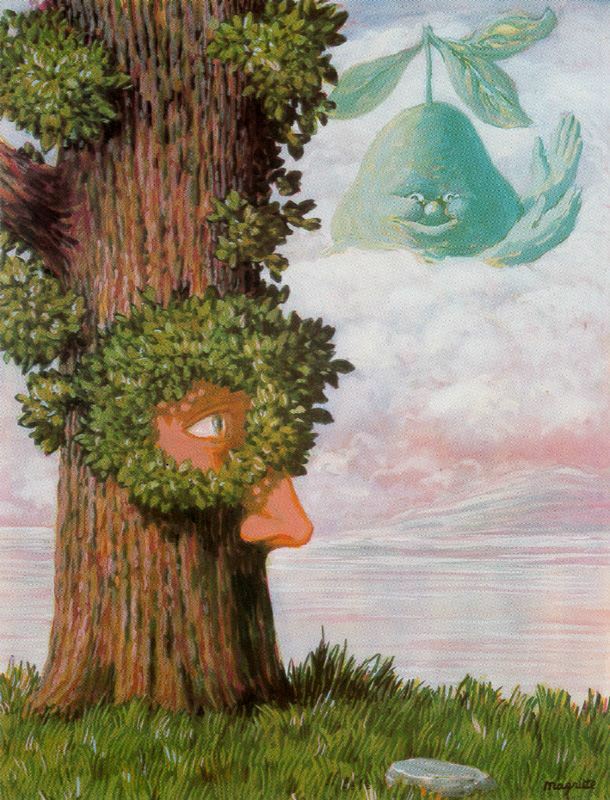
Alice in Wonderland (Alice au pays des merveilles) 1952
Magritte was fascinated by Lewis Carroll's Alice in Wonderland. In fact the two Carroll novels (Through the Looking Glass) were highly regarded by most surrealists including Andre breton. In the 1936 after the Surrealists exhibition that Mesens organized the British surrealists were dubbed 'the Children of Alice,' while others stressed its international character.
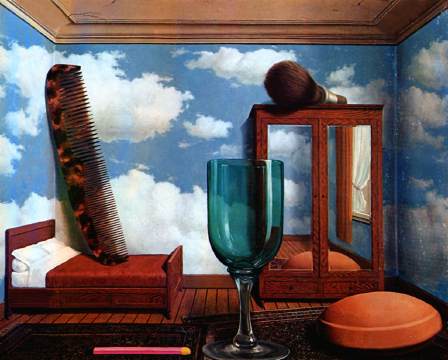
Personal Values 1952
Truly one of Magritte's best examples of magnification is Personal Values 1952. For me, the other outstanding attribute is the cloud wallpaper. Surprisingly Magritte's agent Alexander Iolas at first rejected this painting as not up to Magritte's standard.
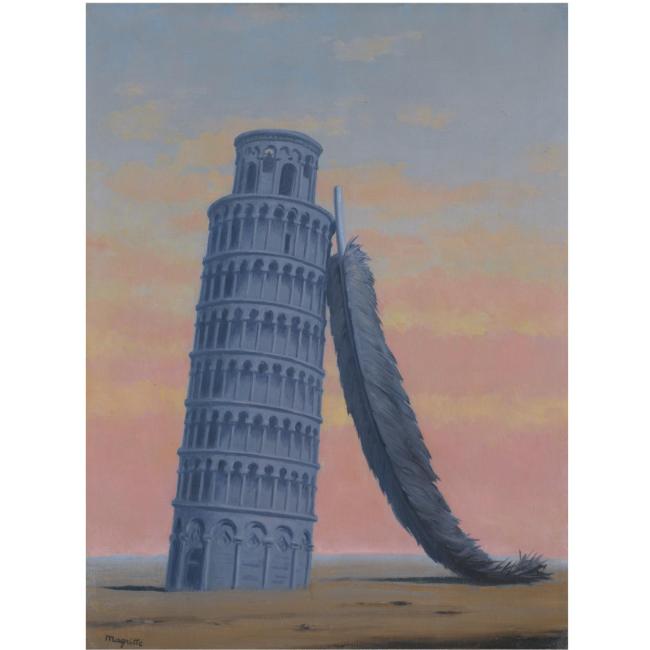
Memory of a Journey (Souvenir de voyage) 1952 5.6 x 7.5 in. / 14.3 x 19 cm .measurements 40 by 30cm. alternate measurements 15 3/4 by 11 3/4 in. Painted in 1958. signed Magritte (lower left) oil on canvas
PROVENANCE: Harry Torczyner, New York (commissioned from the artist)
Bodley Gallery, New York (acquired from the above by 1962)
Private Collection, USA (acquired from the above in 1964. Sold: Sotheby's, London, 4th December 2000, lot 3)
Purchased at the above sale by the present owner
EXHIBITED: New York, Bodley Gallery, Magritte, 1962, no. 9, illustrated in the catalogue
Philadelphia, Philadelphia Museum of Art, Summer Loans, 1970
New York, Sidney Janis Gallery, Magritte, 1977, no. 17 (titled La Nuit de Pise)
LITERATURE AND REFERENCES: Harry Torczyner, Magritte, Ideas and Images, New York, 1977, no. 85, illustrated p. 61 (titled La Nuit de Pise); Harry Torczyner, L'Ami Magritte: correspondance et souvenirs, Antwerp, 1992, no. 48 (discussed in a letter from Magritte to Torczyner, 8th October 1958) & no. 51 (discussed in a letter from Magritte to Torczyner, 20th October 1958); David Sylvester (ed.), Sarah Whitfield & Michael Raeburn, René Magritte, Catalogue Raisonné: Oil Paintings, Objects and Bronzes 1949-1967, London, 1993, vol. III, no. 881, illustrated p. 294
CATALOGUE NOTE: Depicting the leaning tower of Pisa 'supported' by a feather, Souvenir de voyage is a remarkable example of the way in which Magritte's art appropriates images from popular culture, and turns them into fantastic compositions. Reproductions of famous paintings, travel brochures, postcards and other souvenirs were often seized upon as sources for his paintings and gouaches, as is the case in the present work. Since the leaning tower of Pisa holds the same mystifying appeal within architecture as Mona Lisa does in painting, Magritte would have certainly relished its status as a popular icon. By adding the feather as a support for the famously unstable building, the artist seeks to subvert the laws of physics, as well as to question the viewer's perception of an image so deeply rooted in common culture.
The present work is one of three oils that Torczyner, a lawyer and friend of Magritte's, commissioned from the artist in June 1958, and was completed by August of that year. When Torczyner questioned the background of this painting, which differs from the sky painted in another version of the tower of Pisa, Magritte explained in a letter of 8th October 1958: 'The Tower of Pisa is also new, with its necessary feather. The background differs from those of the other versions of this picture, so that they can be distinguished one from another – and also so as not to lose the possibility of seeing the Tower against a sky lit by the setting sun' (quoted in D. Sylvester (ed.), op. cit., p. 294).
The idea of the leaning tower of Pisa originated in a drawing of 1949 and a gouache of 1952, both depicting the building leaning against an oversized upright spoon. The image of the tower 'supported' by a feather first appeared in an oil of 1953, with a more literal title La Nuit de Pise. The title Magritte chose for the present work, that first appeared in a 1926 oil, was conceivably inspired by J.A. Gobineau's book Souvenirs de voyage, which Magritte had in his library. Its more poetic resonance certainly struck a chord with the artist and his inclination for unusual titles, and emphasises the ubiquitous appeal of the image.
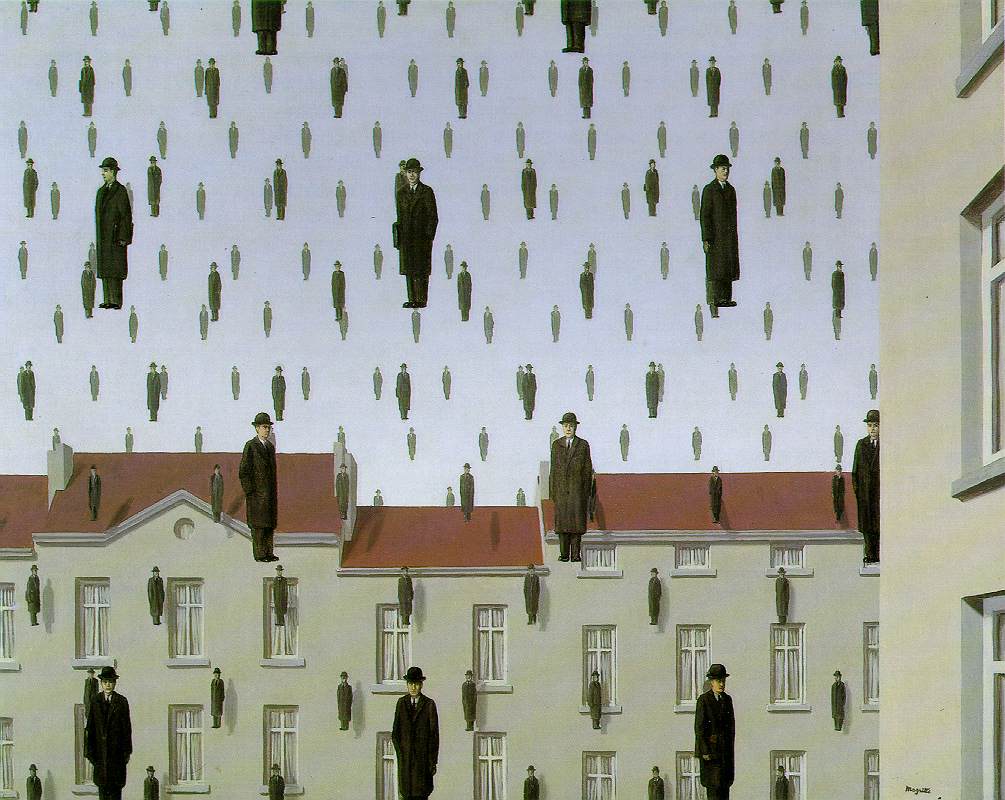
Giaconda 1953
Giaconda is one of Magrite's best known paintings featuring the bowler hatted men raining from the sky. Giaconda is one of Magritte's best uses of duplication (see also The Month of the Grape Harvest), a process he began in 1926 with several mirror images (see: Foolhardy). The duplication is not exact making it more real, and his use of perspective creates the perfect illusion.
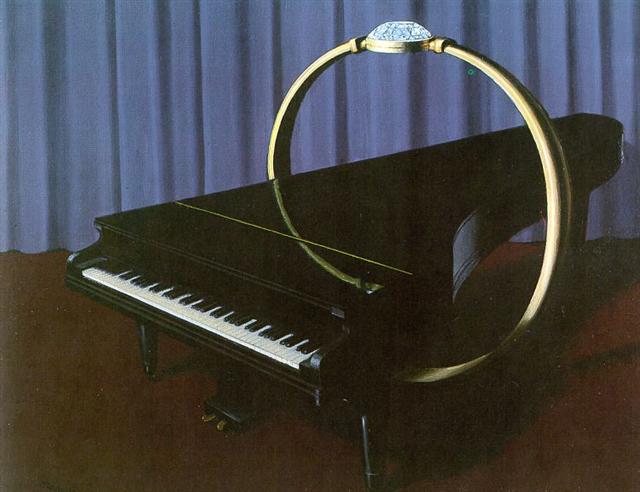
The Happy Hand (La Main Heureuse) 1953
Magritte's brother Paul and his closest patron Mesens both played piano. Magritte made a less one sketch of this before he started the painting. Basically what Magritte is trying to do in his The Happy Hand, is use the principle of association. It's a simple yet confounding principle. What does the piano have to do with the ring? You play the piano with your fingers and a ring goes on your finger- therefore by association the piano goes with the ring.
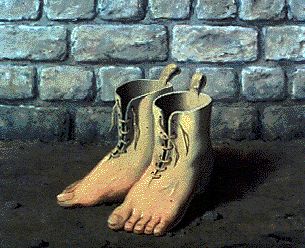
The Red Model III 1953
As far as I can tell this is the 1953 oil version although he painted many diferent versions. It could also be the 1947 gouche version. Alexander Iolas, Magrittes agent starting in 1947, wanted Magritte to paint more paintings like The Red Model, so Magritte happily obliged.
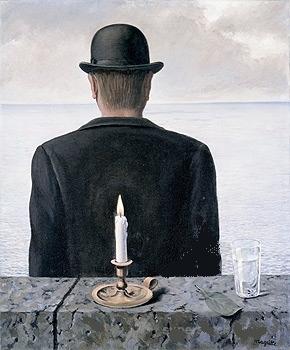
The Song of the Sirens (Le Chant des Sirenes) 1953
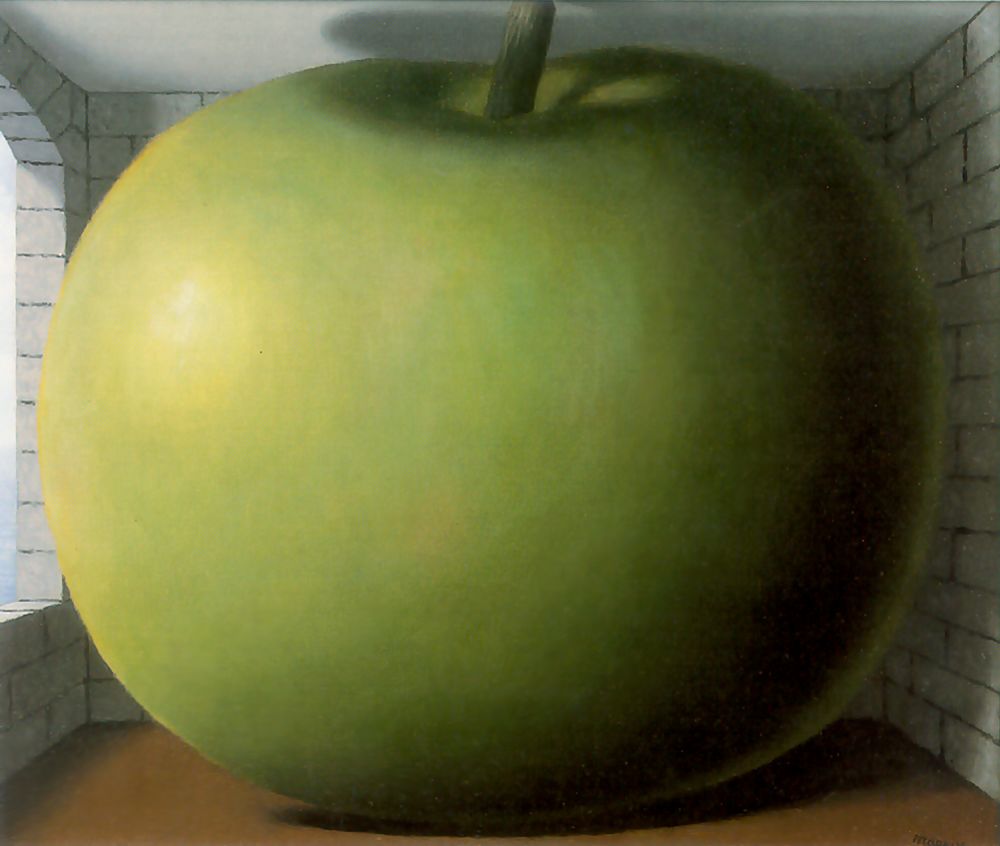
The Listening Room I- 1958
Another version was done in 1953.
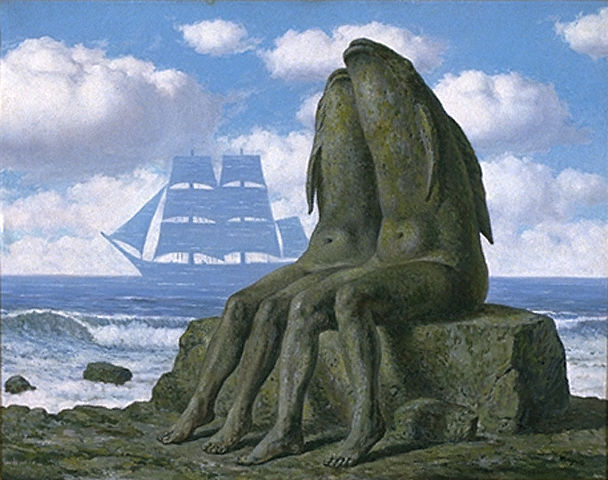
The Wonders of Nature (Les Merveilles de la nature) 1953, 30.5 x 38.6 in. / 77.5 X 98.1 cm
Oil on canvas 30 1/2 x 38 5/8 in. (77.5 x 98.1 cm) Framed: 38 1/4 x 46 1/4 x 2 1/2 in. (97.2 x 117.5 x 6.4 cm)
Gift of Joseph and Jory Shapiro 1982
René Magritte is among the best-known Surrealists. His visionary work has influenced artists such as Marcel Broodthaers, Robert Gober, and Allan McCollum, as well as the imager in many advertisements and popular movies. A painting such (The Wonders of Nature) (1953) illustrates fully Magritte’s poetic sensibility. Here he has depicted two fish-headed lovers apparently joined in song. The painting betrays an affinity to fellow Surrealist Salvador Dali, yet conveys a greater sense of whimsy and humor than the more bizarre and sexually provocative works of Magritte’s Catalonian contemporary.
The conventional mermaid form of the fish-tailed, human-torsoed creature is reversed in as Les Merveilles de la nature, making a creature of fantasy even more unreal. Despite their petrification in stone, the figures appear to be very much alive, with an uncannily human quality, as Les Merveilles de la nature is exemplary of Magritte’s use of the theme and appearance of petrification throughout the 1950s. The painting also contains visual elements found in earlier paintings, such as the ghost ship that blends with the waves on the horizon, which made its first appearance in The Seducer (1950), or the figures themselves, found in an earlier incarnation Collective Invention (1935).
Magritte, like many of the Surrealists, was well acquainted with the prose poem Les Chants de Maldoror by the nineteenth-century French poet Isidore Ducasse, who worked under the pseudonym Comte de Lautréamont. Among the illustrations that Magritte created for a 1948 edition of Lautréamont’s work was a depiction of a fish with human legs sitting on a rock by the sea with a small ship coursing the waves in the distance. This association may account for the confusion over the painting’s title, once given as The Lovers in a 1964 exhibition in Little Rock, Arkansas, and for a long time known at the MCA as Song of Love. Magritte had informed Joseph and Jory Shapiro, the original owners of the work, that the title was Le Chant d’amour. Yet, when asked by his friend Harry Torezyner at the time of his retrospective at The Museum of Modern Art in 1965, Magritte said that he could not remember the title. Research for the recent catalogue raisonné of Magritte’s work revealed the painting’s actual title and the date of creation, proving that the painting had been in a mermaid theme exhibition and a solo exhibition at La Siréne in Brussels in 1953, thereby identifying the sole work unaccounted for from this period, Les Merveilles de la nature.

The Enchanted Realm (Close Up)

The Enchanted Realm (Close-Up)
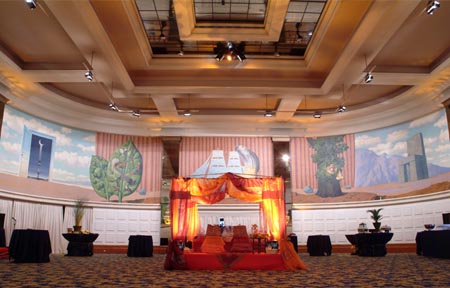
The Enchanted Realm in the Knokke-le-Zoute casino
The Enchanted Realm (also The Enchanted Domain) is Magritte's masterful series of 8 canvases done in 1953. Each canvas recreates the best versions of his earlier paintings. Above is the mural, I'm including all 8 paintings below:
%201953.jpg)
Le Domaine Enchanté (I) 1953
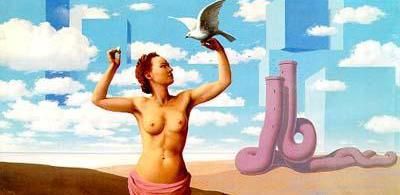
Le Domaine Enchanté II, 1953
%201953.jpg)
Le Domaine Enchanté (III) 1953
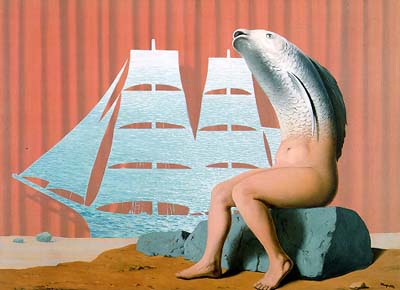
Le Domaine Enchanté IV, 1953
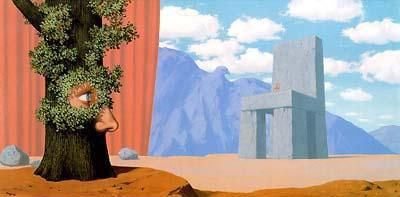
Le Domaine Enchanté V, 1953
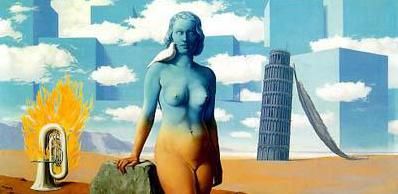
Le Domaine Enchanté VI, 1953
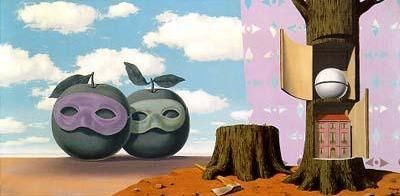
Le Domaine Enchanté VII, 1953
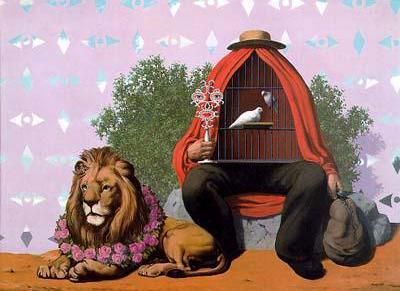
Le Domaine Enchanté VIII, 1953
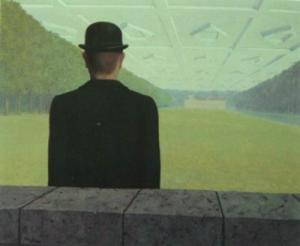
The Great Century 1954
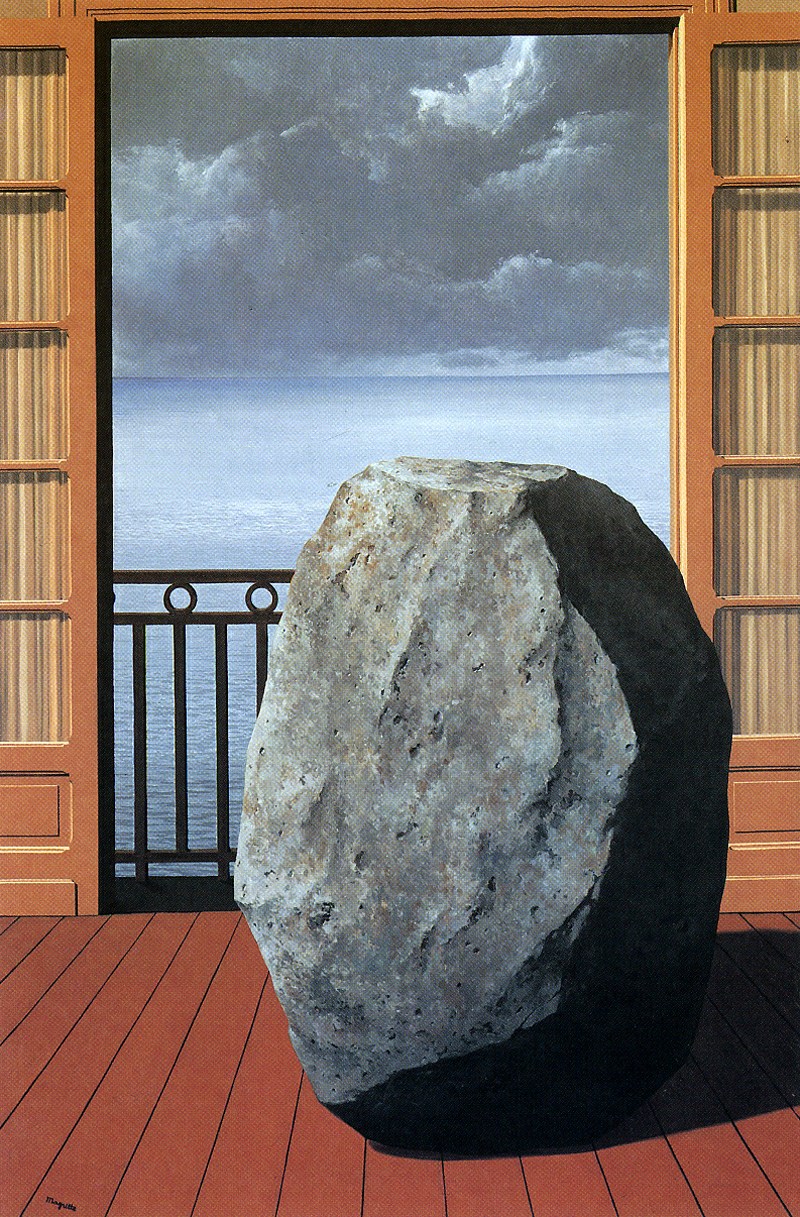
Invisible World (Le Monde invisible) 1954
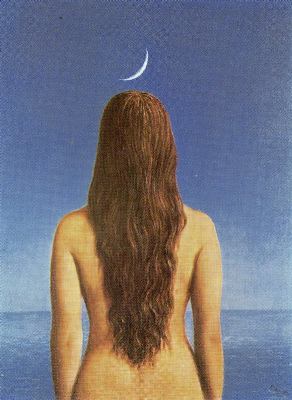
The Cloak of the Night or The Evening Gown (El vestido de noche) 1954
Magritte painted a complimetary work with a bowler hatted man and a quarter moon facing the other direction.
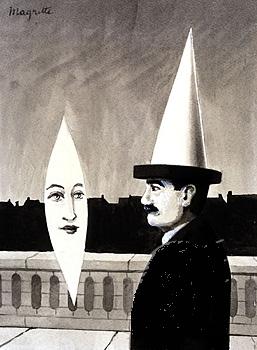
The Truth In Her Jasmine Bouquet (La Verite Dans Son Bouquet de Jasmines) 1954
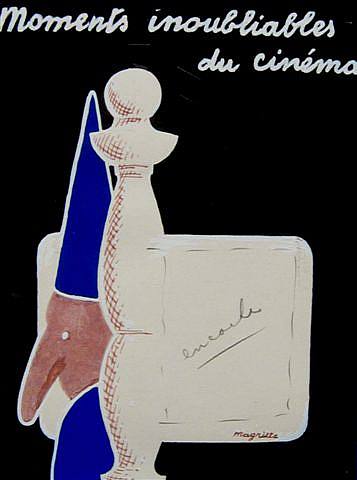
Moments Inoubliables du Cinema, 1954 Gouche on paper 18 x 13.8
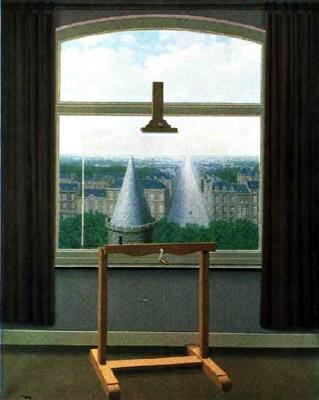
Where Euclide Walked (Les promenades d' Euclide) 1955, oil on canvas
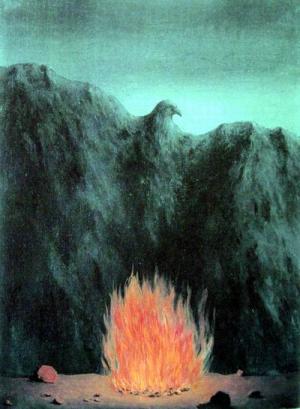
The Spot on the Map- 1955
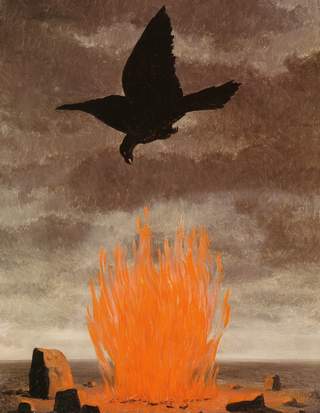
The Fanatics (Les fanatiques) 1955
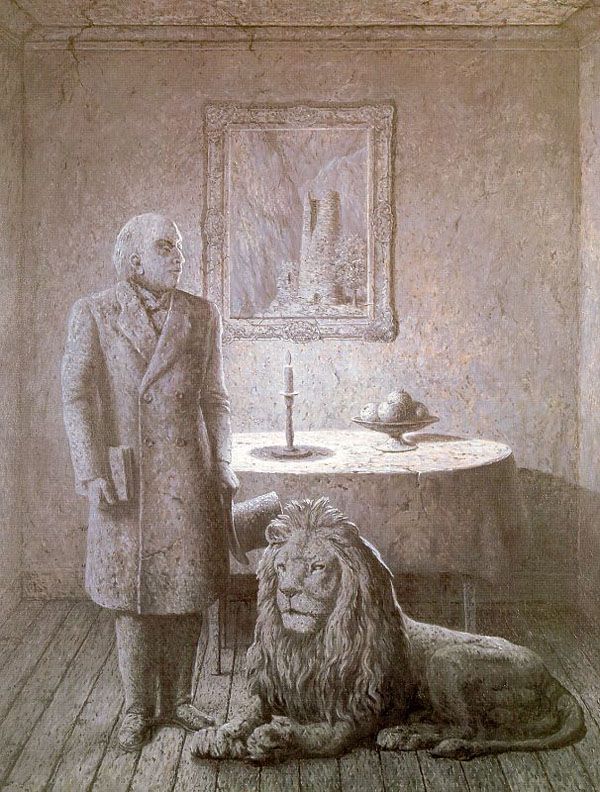
Memory of a Journey III (Souvenir de Voyage III) 1955
One of his best know "Memory of a Journey" paintings featuring a portrait of his good friend Marcel Lecomte.
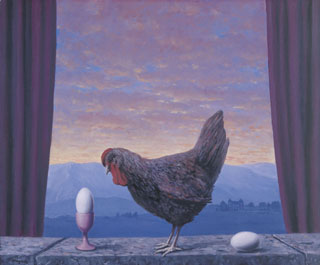
A variation of sadness (Variante de la Tristesse) 1955
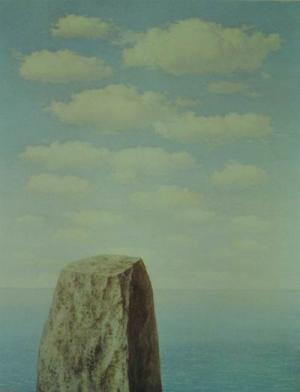
The Origins of Language (Les origines du langage) 1955
"Les origines du langage" is reminiscent of Georges Seurat's 1885 painting, Le Bec du Hoc a Grandcamp. Magritte did several other versions with this theme including "Le bal masqué" and the 1961 "The recall of the order (Le rappel à l’ordre)."
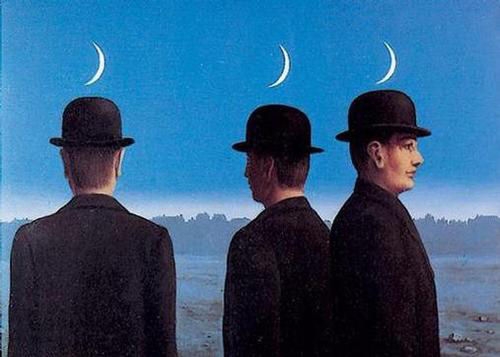
Mysteries of the Horizon (Le Chef-d'Oeuvre ou Les Mysteres) 1955
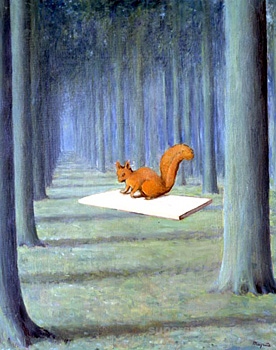
The Orchestra Conductor (Le Chef D'orchestre) 1955
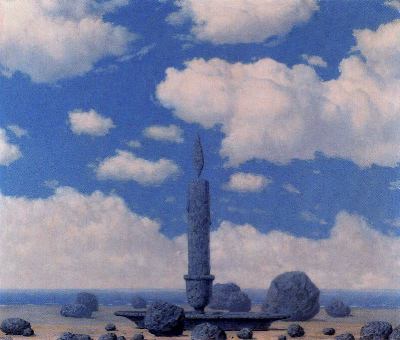
Memory of a voyage IV 1955
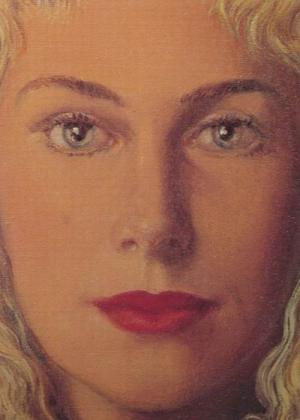
Anne-Marie Crowet 1956
According to Magritte, Anne-Marie Crowet possessed an ideal face. Her face is used for The Ignorant Fairy painting and subsequent murals the 1953 casino mural and the 1957 mural for the Palais des Beaux-Arts in Charleroi. A similar face appears as early as 1939.
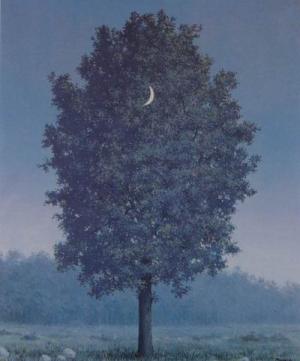
Sixteenth of September (Le Seize Septembre) 1956, 23.6 x 19.7 in. / 60 x 50 cm
Trees are a recurrent subject in his work. As Magritte stated: "Growing from the earth to the sun, a tree is an image of certain happiness. To perceive this image we must be immobile like the tree. When we are moving, it is the tree which becomes the spectator. It is witness, equally, in the shape of chairs, tables and doors, to the more or less agitated spectacle of our life. The tree, having become a coffin, disappears into the earth. And when it is transformed into fire, it vanishes into air." Here Magritte superimposes a crescent moon in front of the tree. The artist referred to his intentional juxtaposition of incongruous objects as "objective stimulus." In reference to this image, Magritte observed: "I have just painted the moon on a tree in the grey-blue colors of evening." Typically, the titles of Magritte's paintings were determined after they were completed. In this case, the title was the idea of Magritte's friend, Surrealist poet Louis Scutenaire.
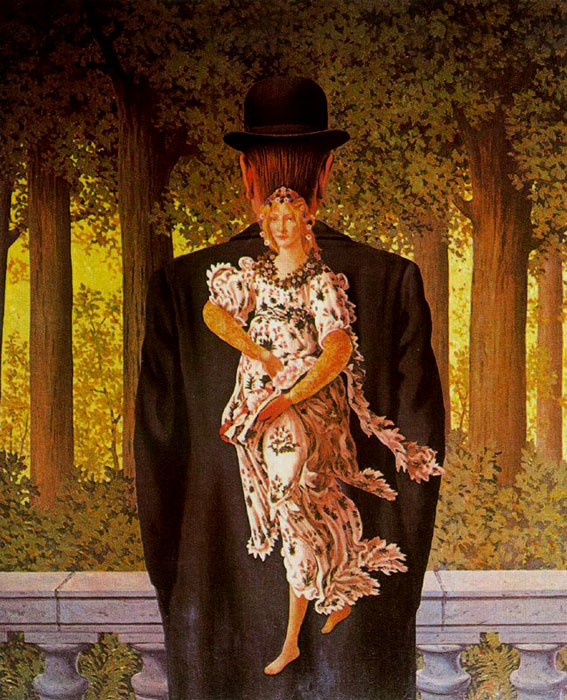
Ready-Made Bouquet 1956
Magritte's referenced Sandro Botticelli's "Birth of Venus" in a wild rendition, barely recognizable, of Venus. This painting is an exact quote from “The Primavera.” Magritte did another very similar version of Ready-Made Bouquet around the same time.
%201956.jpg)
Untitled (Shell In The Form Of An Ear) 1956
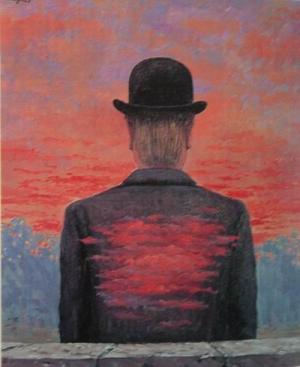
The Poet Recompensed (Le Poete recompense) 1956
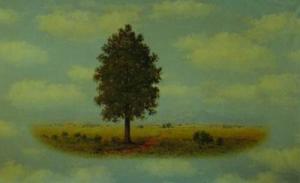
The Territory (Le Terrhoire) 1957

The Ignorant Fairy (Mural) 1957
Here is a small image of Magritte's 1957 mural a version of "La Fée ignorante" (The Ignorant Fairy) from his 1950 painting of the same name which appears the Hall of Congress of the Palais des Beaux-Arts de Charleroi
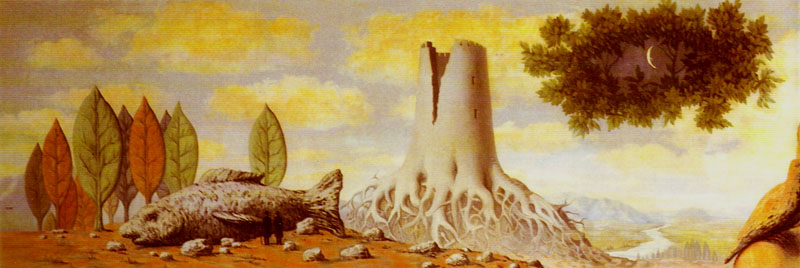
The Ignorant Fairy Mural (Close up 1) 1957
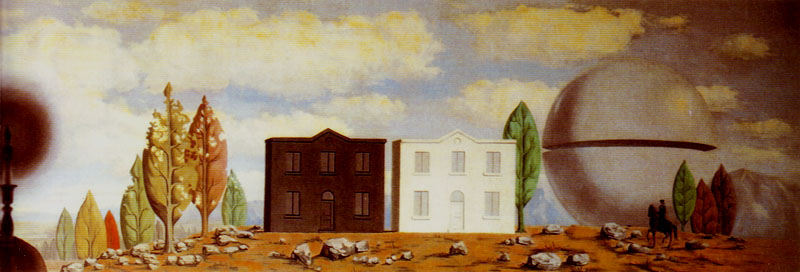
The Ignorant Fairy Mural (Close up 2) 1957
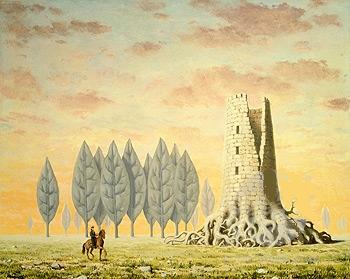
Untitled- Variation Ignorant Fairy 1957
Not sure of the title, it was mistitled as The Enchanted Domain 1957.
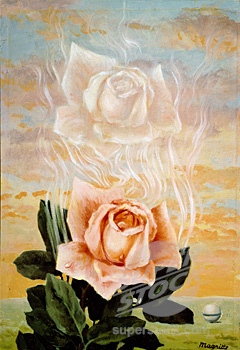
Enchanted Domain (title?)1957
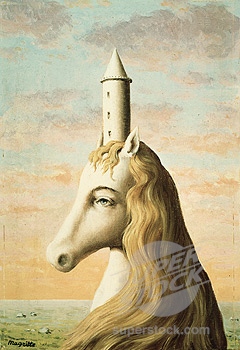
The Enchanted Domain (title?) 1957
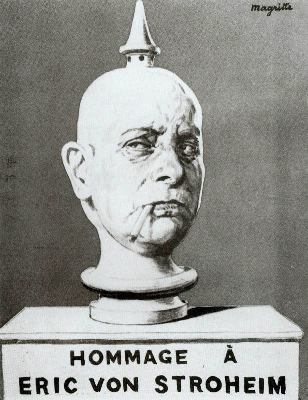
Hommage à Eric von Stroheim 1957
This witty portrait was done by Magritte as an invitation to L'Ecran du Seminaire des Arts. Erich von Stroheim (September 22, 1885 – May 12, 1957) was an Austrian-born star of the silent film age, lauded for his directorial work in which he was a proto-auteur. As an actor, he is noted for his arrogant Teutonic character parts which led him to be described as "not a character actor, but what a character!". Playing villainous German roles during the Great War, he became known as "The Man You Love to Hate".
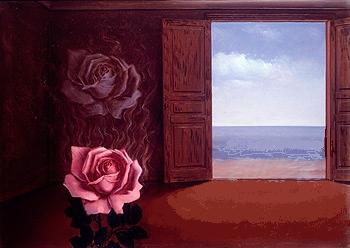
The Meaning of Modesty (Le Sens de la Pudeur) 1957
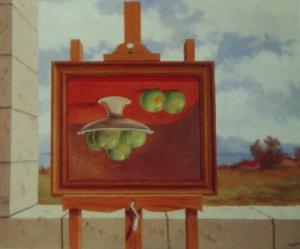
The Alarm Clock (Le Reveille-matin) 1957
Magritte used the upside down painting to better effect with his 1959 version titled, Le Sabbat. Magritte used the same image in a later lithograph, similarly titled "The Morning Awakening."
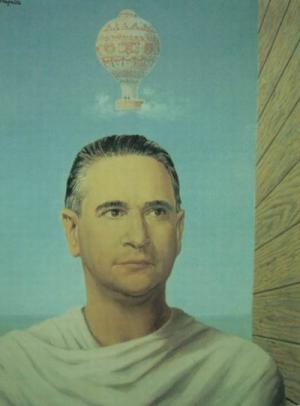
Harry Torczyner or Justice Has Been Done- 1958
In October 1957 Magritte met Harry Torczyner (1910-1998), a Belgian lawyer based in New York who was interested in poetry and art. Torczyner became Magritte's patron, friend and adviser for the rest of Rene's life. Their letters were recently published in "Magritte/Torczyner: Letters Between Friends" by Rene Magritte (Author), Harry Torczyner (Author), Richard Miller (Translator).
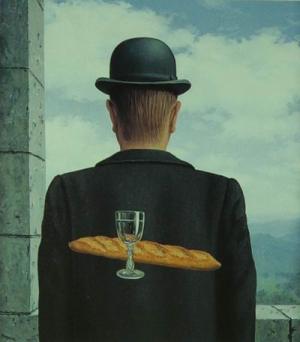
The Intimate Friend (L'Ami intime) 1958
This is a similar setting as 1958 "The Golden Legend" and (see below) but this time there's just one loaf of bread and one wine glass and of course his bowler hatted man with his back turned blocks the view. In my opinion these are religious icons and Magritte used them frequently from the mid-1940s onward.
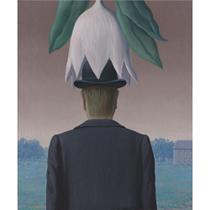
L'opaki- 1958; 23 1/2 by 19 5/8 in. (59.6 by 49.7cm) Signed Magritte (lower right); titled L'okapi and dated 1958 on the reverse. Oil on canvas

The Okapi (Okapia johnstoni) is a giraffid artiodactyl mammal native to the Ituri Rainforest, located in the northeast of the Democratic Republic of the Congo, in central Africa. Although the Okapi bears striped markings reminiscent of the zebra, it is most closely related to the giraffe.
PROVENANCE:Alexander Iolas Gallery, New York (acquired from the artist in 1958)
Jacques Kaplan (acquired from the above in 1965)
Acquired from the above by the family of the previous owner in 1965
EXHIBITED:New York, Alexander Iolas Gallery, René Magritte, 1959
Dallas, Museum for Contemporary Arts & Houston, Museum of Fine Arts, René Magritte in America, 1960-61, no. 65
Little Rock, Arkansas Art Center, Magritte, 1964
LITERATURE AND REFERENCES: Letter from René Magritte to Maurice Rapin, April 14, 1958
José Pierre, Magritte, Paris, 1984, illustrated p. 13
David Sylvester (ed.), Sarah Whitfield & Michael Raeburn, René Magritte, Catalogue Raisonné, Oil Paintings, Objects and Bronzes 1949-1967, vol. III, London, 1993, no. 872, illustrated p. 286
NOTES: L'Okapi explores the single most iconic motif of Magritte's oeuvre, that of the bowler-hatted man. Seen from behind, against an undefined landscape, his head crowned by a mysterious over-sized flower, the protagonist encapsulates the enigmatic, timeless quality that defines Magritte's art.
The image of the bowler-hatted man first appeared in his painting of 1926 titled Rêveries du promeneur solitaire, in which the man is seen from the back, against a dark evening landscape. Used in a number of paintings throughout the artist's career, and most famously in Golconde of 1953, now in the Menil Collection in Houston, the bowler-hatted man appears in various guises. He is sometimes depicted from the back, as in the present work, sometimes from the front, his face obscured by an object placed in front of it, as a dark contour faintly visible against the night sky, or fossilized into a block of stone. Often he is no more than a silhouette, providing a frame in which another subject is depicted. What is common to all of them is the fact that the man remains impersonal, an individual transformed into a universal object. As Suzi Gablik described him: "Magritte's bowler-hatted man is more like a figure in a book than a human being, but a figure with all the inessential elements left out... Impassive and aloof he fixes the world in his gaze, but often his face is turned from view, dislocated, or otherwise concealed or obliterated by objects, as if expressing a universal disinclination, for which there exists no complementary inclination" (Suzi Gablik, Magritte, London, 1991, p. 162).
In L'Okapi, the man's bust occupies the foreground of the composition, as he gazes over the landscape and the plain, cloudless sky, scenery reminiscent of a stage design rather than an actual landscape. Coming from an unknown source above the scene that is depicted, a white flower with three leaves is clasping the man's bowler-hat, and appears to be devouring and protecting him at the same time. The image of the upturned flower is rare within Magritte's oeuvre; while objects such as a loaf of bread, an apple or a bell often appear in his paintings and gouaches, usually obscuring the face of the man, this flower is not repeated in other works. Discussing the significance of another flower, a rose, in a letter of 1957, Magritte wrote: "The presence of the rose next to the walker signifies that the man, wherever his destiny may lead him, is always under the protection of an element of beauty" (quoted in David Sylvester, op. cit., vol. IV, p. 192).
Between 1955 and 1958, Magritte and his friend Maurice Rapin, who was associated with the Surrealist group, corresponded regularly. In a letter of April 14, 1958, Magritte sent Rapin a sketch of the present work, calling it L'Abîme quotidien (The Daily Abyss). At a later stage, however, he changed the title of the work to L'Okapi, adding to its mysterious quality by alluding to the exotic, little known animal. Visually, it might have been the black and white pattern created by the juxtaposition of the man's hat and the flower that reminded Magritte of the stripes that characterize the okapi.
Executed in the last decade of Magritte's life, L'Okapi exemplifies the clarity of thought and execution the artist reached in his mature works. Unlike his earlier paintings, in which he often combined various motifs in a single composition, in his later years Magritte arrived at an economy and purity that allowed him to focus on a single idea, thus creating a stronger visual impact. Whereas in his earlier works the bowler-hatted man's face, or indeed his entire body, are replaced by a landscape or a cloudy sky, in the present work he is reduced to the minimal elements of his generic suit and hat, set against the imaginary landscape which further emphasises the powerfully existential, timeless quality of this image.
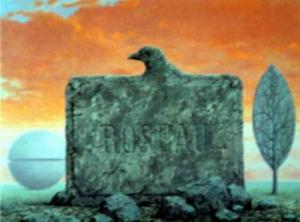
The Fount (Fountain) of Youth II (La Fountaine de jouvence)- 1958
This painting is similar to The Smile with a tombstone engraved "roseau" on it (in french it means "reed"). Magritte did another version in 1957 and on that grave it spells "coblenz."
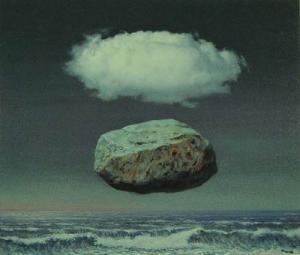
Clear Ideas (Les Idees claires) 1958
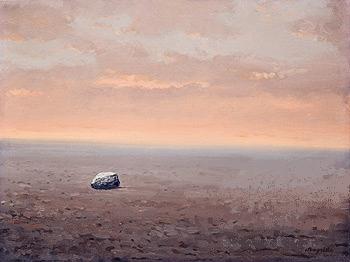
La Calligraphe 1958
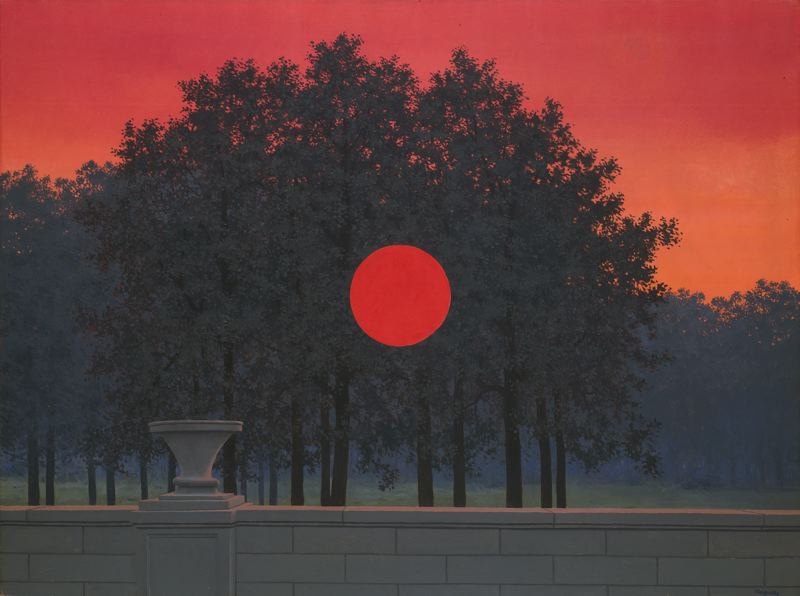
The Banquet- 1958
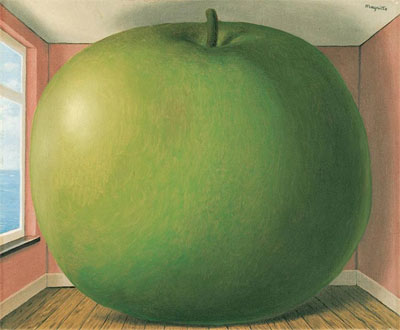
The Listening Room I- 1958
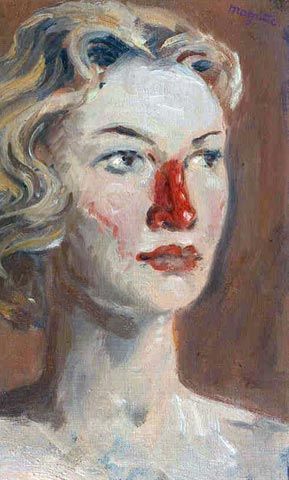
The Penelope Canvas (La Toile de Pénélope) 1958
One of the few impressionist style paintings Magritte did after the 1940s.
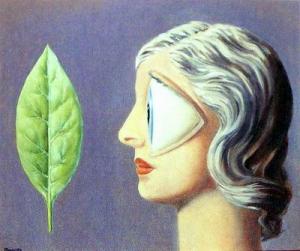
Masson's Wife (Femme du masson) 1958
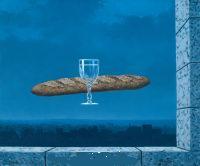
Inevitably (La Force des Choses) 1958
This and the next painting use the bread of life symbol, one of Magritte's iconic religious images. The glass would represent the water of life. It's inevitable that we will have to deal with religion and the role it will paly in out lives.
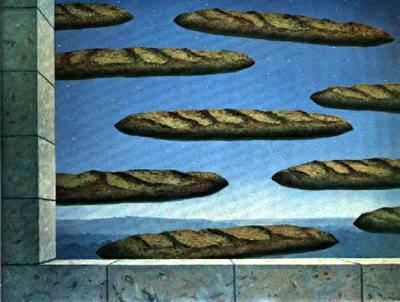
The Golden Legend 1958
The loaves of bread resemble something from a Byzantine mosaic, circa 500 AD. By using duplication, a technique Magritte used for many of his important works, he creates a powerful painting, as if the bread was alive. "This standing motionless upon the golden threshold of the wide open gate of dreams," Edgar Allen Poe.
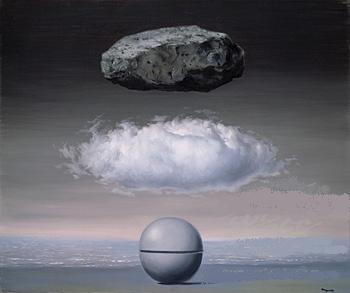
The Familiar World (Le Monde Familier) 1958
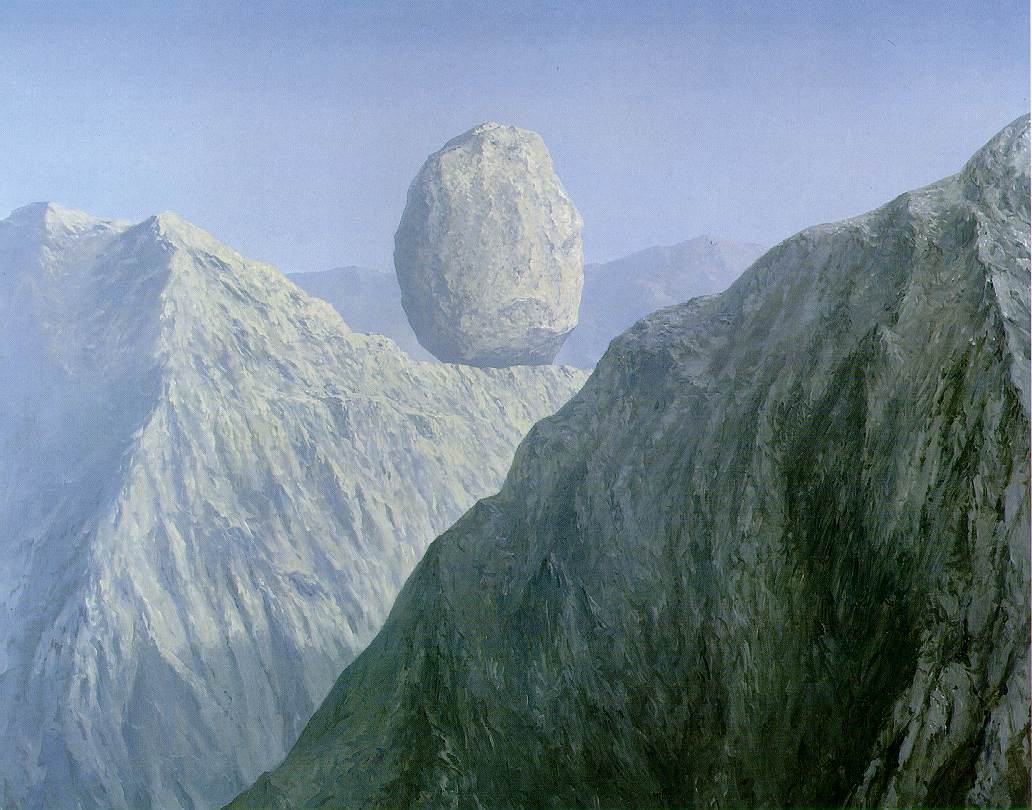
The Glass Key (La Clef de Verre) 1959 Oil on canvas. 129.5 x 162 cm. The Menil Collection, Houston, TX, USA.
The Glass Key features a giant boulder balancing delicately on a ledge, a geological impossiblity. The Glass Key title comes from Dashiell Hammett, THE GLASS KEY (1930) was Hammett's favorite among his novels. The central character, Ned Beaumont, was partly a self-portrait: a tall, thin, tuberculosis-ridden gambler and heavy drinker. Dashiell Hammett (1894-1961) was an American novelist who also worked as a screenwriter in Hollywood. He wrote his first fiction under the pseudonym Peter Collinson. Hammett's best known books include THE MALTESE FALCON (1930), filmed three times. It introduced detective Sam Spade who is investigating the murder of his colleague, detective Archer.
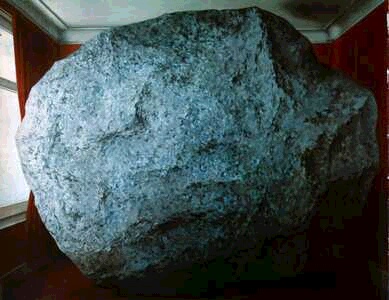
The Anniversary (L’Anniversaire) 1959
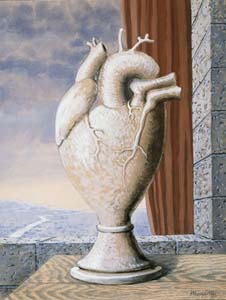
The Malicious Sack (Le Sac à malice) 1959 gouche
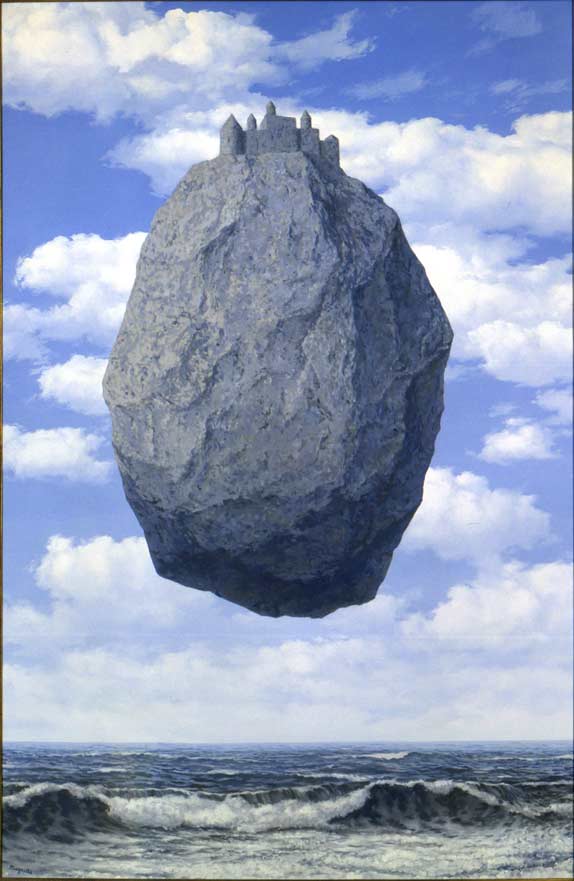
The Castle in The Pyrenees (Le Chateau des Pyrenees) 1959
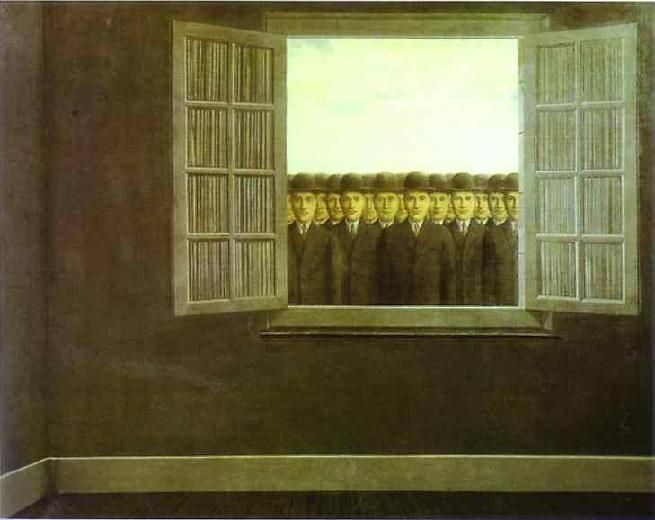
The Month of the Grape Harvest 1959
In his painting Le Mois des vendanges (The Month of the Grape-harvest, 1959, cat. 83) we become gradually aware of the disquieting contrast between an empty room and a congeries of almost identical men in Magritte’s famous bowler hat, gazing in through the open window. This is very similar to the three men staring through the window in "The Menaced Assassin" done in 1926.
Magritte use duplication (using an exact copy of a person or object) as an effect in his early career (Foolhardy, 1927) and continued using variations of it in some of his greatest works including Golconde.
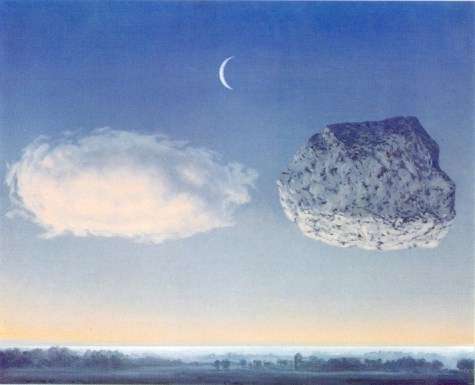
The Battle of the Argonne (La Bataille de l'Argonne) 1959, 19.7 x 24 in. / 50 x 61 cm
In La Bataille de l'Argonne (The Battle of the Argonne, 1959) a rock can float as easily as the adjacent cloud and thereby invites comparison because of its relative height and size.
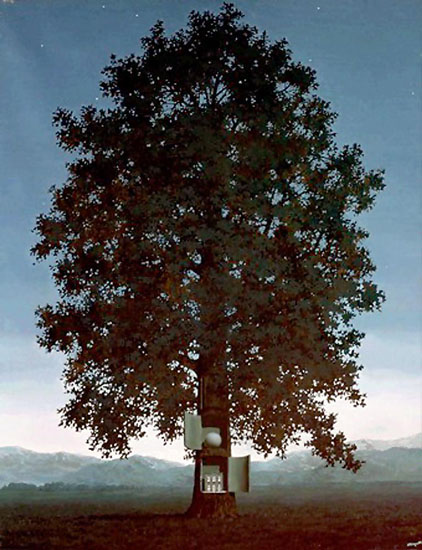
The Voice of Blood IV (La Voix du Sang IV) 1959
This version is similar to another tree painting "September 16" done in 1956.
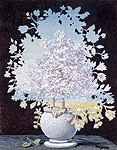
An Eclair (L'eclair) 1959
This is one of a series of gouache based on The Plagiarism (Le Plagiat- 1939-40) depicting a vase of flowers on a table in an interior setting. The spray of flowers is depicted as a cut-out silhouette, acting as a window onto a landscape of grassland, trees and shrubs. This superimposition of forms and the dialogue that Magritte establishes between revelation and concealment is a frequent tactic in his work.
The main difference from The Plagiarism (Le Plagiat- 1939-40) is the bird's nest with its three white eggs. The title of the Le Plagiat was coined by Magritte's friend, the poet Marcel Marïen. Magritte responded: “The title Plagiary is very strong and very fine. I am appropriating it.” Truly a bad pun between friends!
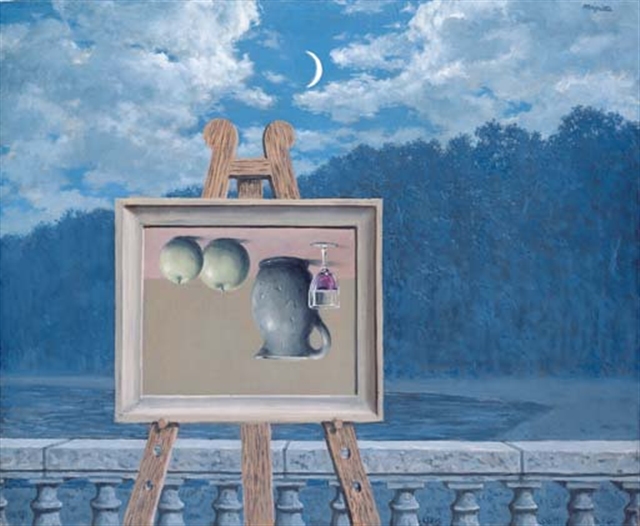
The Sabbath (Le Sabbat) 1959
Rene Magritte's 1959 "Le Sabbat,'' with an upside-down easel in a landscape, took 4.5 million pounds from a European bidding on the phone. It was once owned by Monaco-based dealer and collector David Nahmad, who said he sold it in 1975 for $100,000. This is a better version of his 1957 painting, "The Alarm Clock"
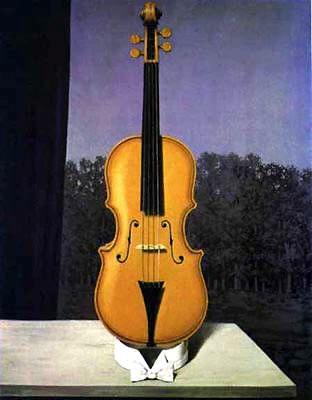
A Little of the Bandit's Soul. 1960. Oil on canvas, 65 x 50 cm.
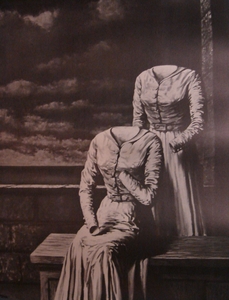
The Horns of Desire (Les Cornes du Desir) 1960
.jpg)
The Married Priest (Le Pretre mane) 1960
The apple with a mask is featured in The Hesitation Waltz- 1950. Eroticism, understood both in light of the Marquis de Sade and Sigmund Freud, was fundamentally important to the Surrealists. In my opinion the apple wearing a mask is displaying a Marquis de Sade type costume. The image of the masked apple first appeared in 1946 for a cover design Magritte did of "The View."
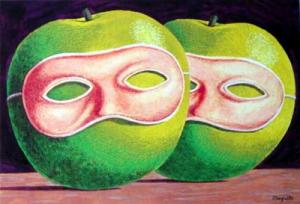
The Married Priest (Litho) gouche- No date given
This became one of a series of lithographs done after Magritte died.
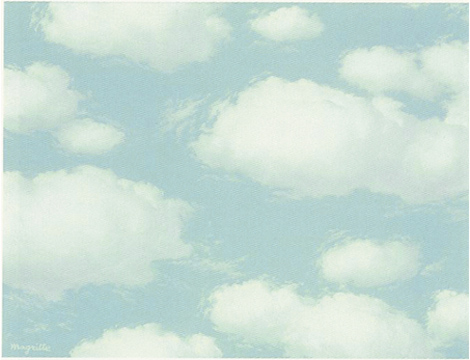
The Curse II (Malediction II) 1960
Claude Spaak commissioned Magritte to do the frist version of this painting, a simple but mystical painting of the sky. In 1951 Magritte used this a the basis for one of his murals that he painted on the ceiling at the Theatre Royal des Galeries Saint-Hubert adding only faint images of blue grelots (bells) to the sky.
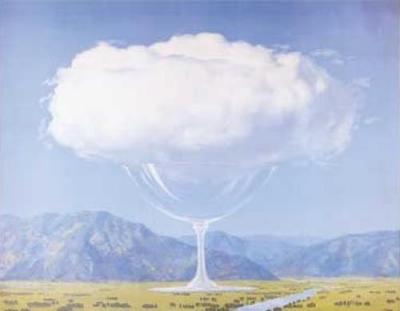
The Heartstring (La Corde Sensible) 1960
He asked, "What kind of wine would you like?"
She replied, "I'd like a cloud please, cummulous, extra fluffy and not too light. That last one I ordered floated out of the glass."
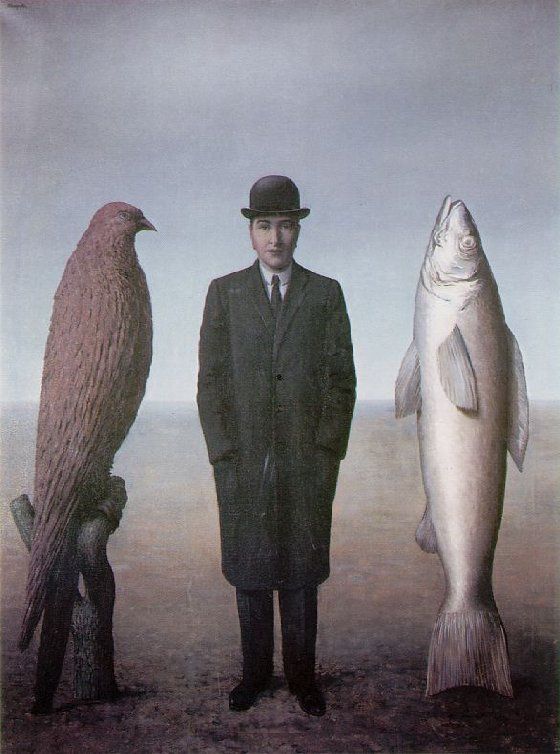
The Spirit of Presence (La Présence d’Esprit) 1960
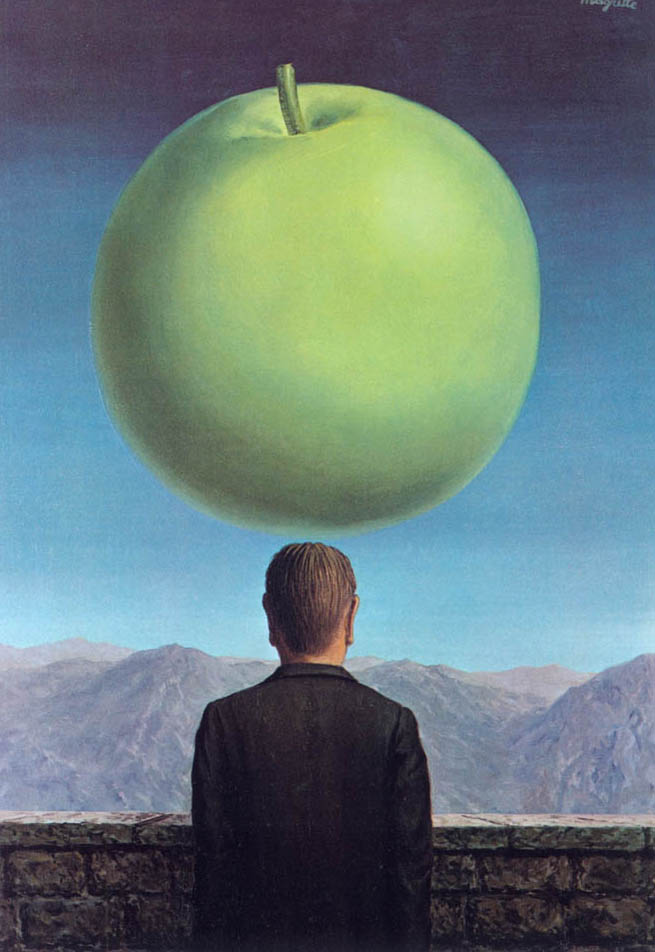
The Post Card- 1960
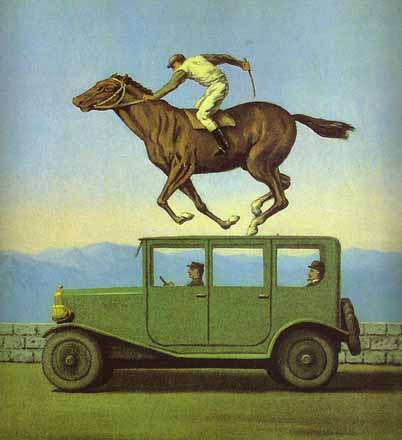
The Anger of the Gods (La Colère des Dieux) 1960
The is essentially a hillarious version of The Lost Jockey done in 1926. The jockey returns, this time riding on top of an automobile.
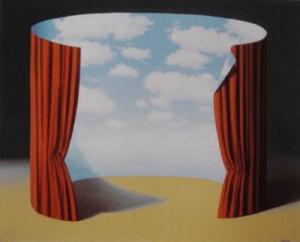
The Memoirs of a Saint (Les Memoires d'un saint) 1960
This is part of a series of paintings done on a stage with curtains that magritte did in the last years of his life (1960- 1967). Other versions include: The Beautiful World (Le Beau Monde)1962; The Wasted Effort (La peine Perdue) 1962; and Mona Lisa- circa 1962
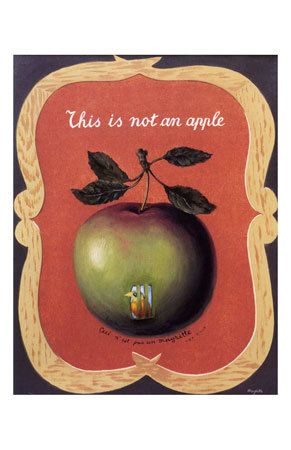
The Forces of Habit (Les Forces de l'Habitude) 1960 Poster
Max Ernst painted a bird cage with a bird on the bottome of Magritte's painting and signed it: This is not a Magritte. Here's a report of the painting and Magritte's reaction:
"Magritte," Pierre continued, "was both someone very serious, very bourgeois, and someone with a great sense of humor who knew how to laugh. He was rather complicated. In Max Ernst's dining room in Paris there was a painting by Magritte, entitled Force of Habit (I 960, cat. no. 15 1), in which a heraldic image of a large green apple is inscribed in English, "This is not an apple." Max and Magritte had exchanged pictures, as artists often do. And Max, in the middle of the apple, had painted a cage with a bird inside. Below this cage, Max had written, "Ceci n'est pas un Magritte - signs Max Ernst." It was pretty funny, at least I thought so. It transformed that painting by Magritte, which was a little boring, into something exceptional. The only problem is that when Magritte came and saw the picture, he laughed politely, but he hated it."
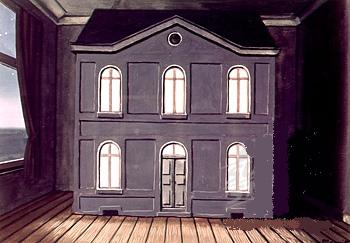
The Apartment of Madame Sundheim- 1960
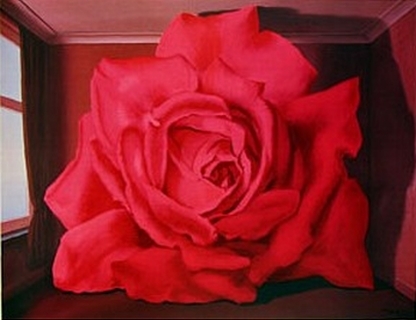
The Tomb of the Wrestlers (Le Tombeau des Luteurs) 1960
This big rose painting is called The Tomb of the Wrestlers and was a commission by Magritte's lawyer and patron Harry Torczyner. "When there is a rose, and one is sensitive to it, one makes it as big as I did so that the rose appears to fill the room," he explains. The title, which Magritte took from a novel by French Symbolist writer Leon-Alinien Cladel, "Ompdrailles, le tombeau des luteurs" (1979), seems appropriate: like the rose, the fighters are something "grandiose," filling the tomb with their struggles.